
Acne Scar Revision & Hyperpigmentation Specialist
In search of proven and safe solutions?
Discover Your Customised Solution
Treating acne scars doesn’t always mean the more expensive, the better. If the root cause isn’t addressed, even the priciest treatments can be ineffective. If you have unlimited time and money, you might choose any treatment available. But if you want real, lasting solutions without complications, this is your answer✅.
Acne scars require specialized procedures that rely on experience and a blend of techniques, tailored to each individual. At BAC Clinic, we prioritize precise, effective treatments that match your lifestyle.
✨”End” your acne scars💯 with 3 expert techniques:
✅ Subcision — Severing fibrous bands beneath scars with specialized tools, minimizing swelling and bruising. Our Microsubcision Program (Blunt Cannular Multilayer) delicately removes these bands across the face, offering clear results from the first session.
✅ Skin Stimulating Therapy — Stimulate the subsurface of scars to plump and thicken, using PN/PDRN/TCA, complemented by other procedures.
✅ Synthesis — Create fresh collagen and reorganize its structure for tighter pores with Infini MFR.
Ideal for those who:
✨ Have various, long-standing acne scars, non-responsive to laser treatments, leading to frustration.
✨ Underwent multiple subcisions, resulting in thicker fibrous bands, needing more precise treatment.
✨ Struggle with ice pick scars, sharp-edged boxcar scars, and wide pores.
✅ Acne scar treatment outcomes have a narrow margin.
👍 Top-quality tools and specific techniques.📌 Noticeable improvement in the first session: about 40–60% (+/- 5–10%).
📌 Maximum improvement with sufficient sessions: up to 90% (+/- 3–7%).
👉 Choosing the right method at a standard price can improve scars by 40–90% (varies per individual).
👉 Consider whether paying more will yield significantly better results. Is a 5–15% improvement worth it, especially when changes are barely noticeable?
😊 Educate yourself before deciding on acne scar treatment.
📌 BAC’s acne scar treatment rates vary by scar type and severity, as treatments, sessions, and tools differ.
Microsubcision Program (Blunt Cannular Multilayer): Starting at 500 THB. Details:
The Acne Scar Subcision Program (Blunt Cannular Multilayer) involves the meticulous dissection and cutting of fibrous bands across the face, sometimes referred to as acne scar surgery. It is a method for treating acne scars by cutting the fibrous bands using specialized small needles, capable of cutting fibrous bands of all types. This technique causes minimal pain and may result in slight bruising, with visible results evident from the first session.
This acne scar treatment involves cutting fibrous bands with specialized small needles, causing minimal pain and slight bruising, with clear results from the first session.
📍Service fees when combined with Picosecond laser or Infini MFR:
👉 500 THB per spot/1,500 THB for the entire face.
When not combined with Picosecond laser or Infini MFR:
👉 900 THB per spot/2,900 THB for the entire face (standard price when not combined with laser)
TCA CROSS and TCA paint (TCA Chemical Reconstruction of Skin Scars) for deep, narrow ice pick and boxcar scars.
Combined with lasers like Picosecond and Infini MFR, starting at 500 THB per spot or 1,200 THB for full face.
Microneedle Fractional RF (Infini MFR USFDA standard): Starting at 9,900 THB, inclusive of additional treatments.
Rejuran Healer and Rejuran S: Starting at 8,900 THB.

“Discover how to visibly improve wide pores and acne scars from the first treatment with the latest laser technology. This advanced solution addresses a variety of skin issues, especially the persistent problem of acne scars which only temporarily improve with other treatments, and can even lead to complications like melasma, burnt skin, or thinner skin unexpectedly. This article holds the answers you’re looking for about acne scar treatment. It introduces the Acne Scar Revision technique that deeply addresses every layer of the skin, exclusively at BAC Clinic.
No matter how advanced medical tools become, patients or those interested in cosmetic services still seek basic knowledge about these medical tools or lasers for skin problems. However, it’s essential to understand that lasers working on the same principle can yield significantly different results and effectiveness. Particularly, tools that stimulate new collagen production in the deeper skin layers are crucial for goals like collagen stimulation, pore tightening, acne scar treatment, and facial lifting. Therefore, it’s vital for patients dealing with these issues to choose tools that can genuinely solve their problems.”
The process of stimulating new collagen production in the dermal layer of the skin primarily involves the application of heat to the dermis. This heat causes injury (ablation) to the subcutaneous collagen. The extent of this injury is indicated by the Coagulation zone, which shows how much the released thermal energy stimulates the cells. The greater the stimulation, the more intense the process of new collagen production. Especially when the collagen in the dermis undergoes reorganization (dermal remodeling), it can more effectively address challenging skin issues. Examples include deep acne scars, wide pores, and also aids in facial lifting, revealing smoother, more refined skin.
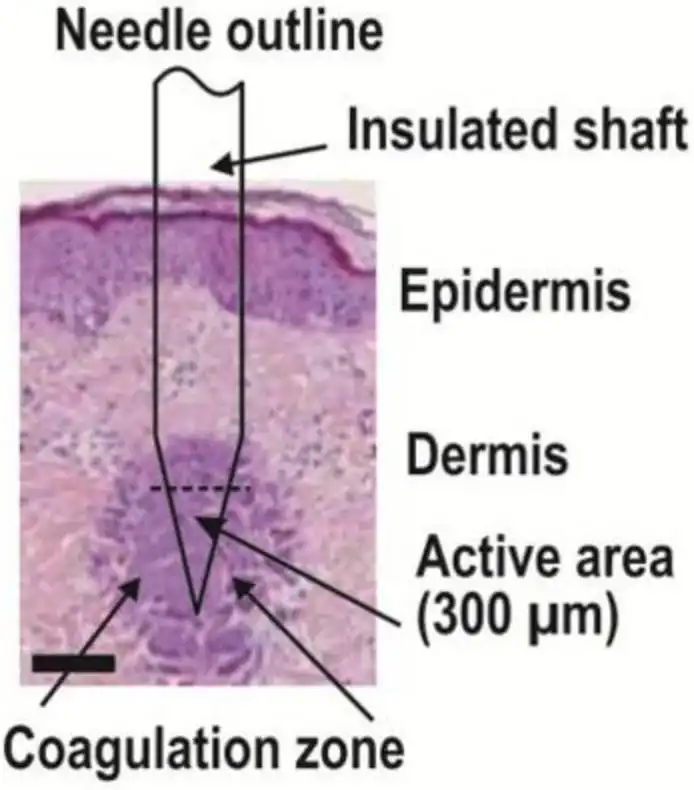
Figure 1 Infini Coagulates the Dermis
Achieving the desired outcome in treatment is greatly influenced by the occurrence of COAGULATION. The more the COAGULATION ZONE is stimulated, the more new skin cells are generated. However, it’s important to note that more than just COAGULATION is needed; this process must occur in the dermal layer (DERMIS). This explains why different Microneedling RF devices yield varying results.
The heat necessary to stimulate skin cells to try to produce new collagen is around 40–45 degrees Celsius. Heat above 65 degrees Celsius causes collagen contraction. Therefore, the more energy delivered to the subcutaneous layer, the clearer the results. However, tools that only deliver RF energy superficially (like Exilis, Venus Freeze, Viora Reaction, 3Deep RF, eMatrix, eTwo, TriPolar RF, ReFirme, Sublime) struggle to deliver the heat at a temperature effective enough for collagen production in the dermis without causing burns. Hence, these tools need to be used in conjunction with cooling mechanisms.
Additionally, using the skin as a conduit for heat to deeper layers makes it difficult to predict outcomes, as cell condition, collagen thickness, and varying fat and water content within cells differ. It’s unpredictable whether the energy will reach the desired level. Too deep energy penetration can kill subcutaneous fat cells, while high energy in superficial layers can cause inflammation and dark spots due to burns.
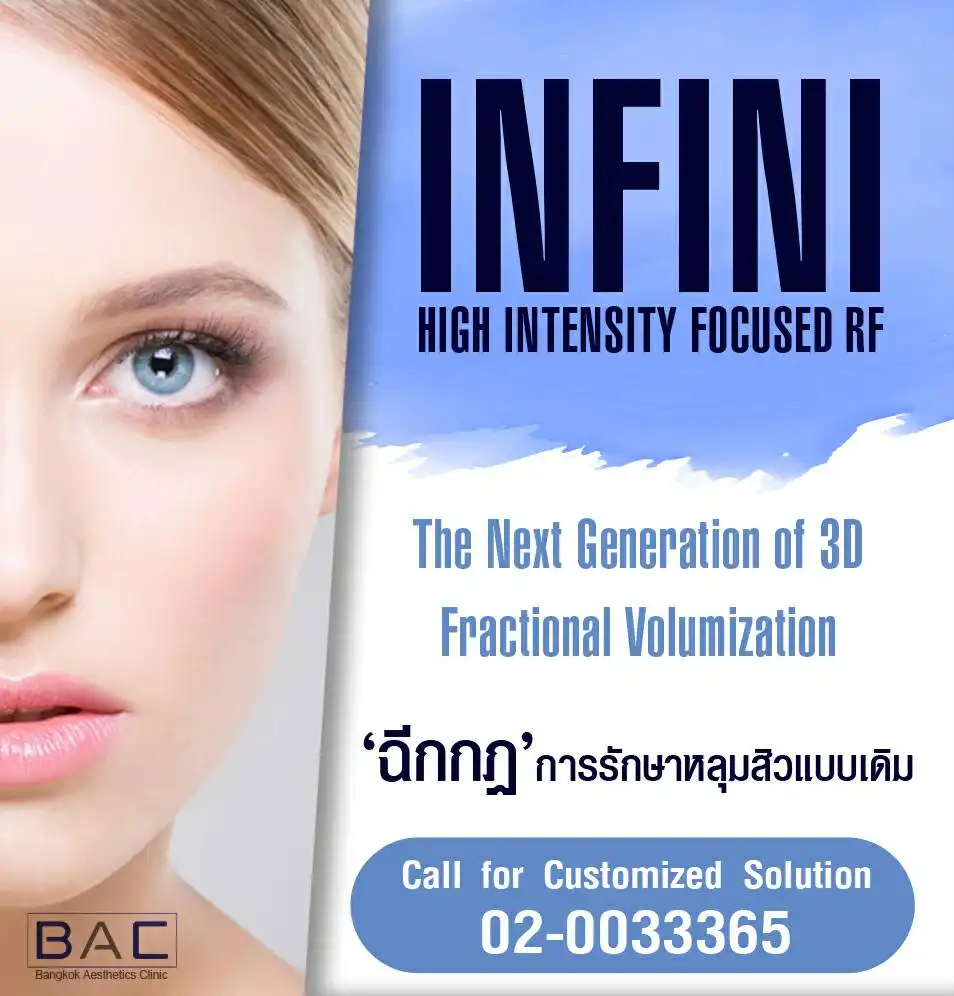
The Micro-needle Fractional RF (Radio Frequency) laser system differs significantly from traditional Laser Skin Resurfacing or ablative lasers like CO2 lasers (e.g., eCO2, SmartXide, Fraxel). While both technologies are effective for treating acne scars, Micro-needle Fractional RF has the advantage of lower downtime and a reduced risk of Post Inflammatory Hyperpigmentation (PIH), making it suitable for darker skin tones.
CO2 lasers, a longstanding technology in acne scar treatment, work by creating controlled damage on the skin’s surface to stimulate collagen production and level out acne scars. However, since they ablate the skin from the top, they can cause crusting and grid-like patterns on the skin, and their penetration isn’t very deep. Additionally, CO2 lasers can make the skin more sensitive to sunlight and are more likely to cause PIH, especially if the energy settings are not properly adjusted, leading to potential burns or even melasma.
Fraxel uses Fractional CO2 technology with a more refined laser emission. Its wavelengths, 1,550 nm and 1,927 nm, are suitable for acne scars and pigmentation, respectively. Fraxel has fewer side effects like redness and crusting compared to CO2 lasers but still carries the risk of PIH due to the similar principle of ablating the top layer of skin. In terms of efficacy, Fraxel is less effective than CO2 lasers; approximately four Fraxel treatments are equivalent to one fractional CO2 treatment.
The E-matrix operates by transmitting energy through a pyramid-shaped tip under the skin, which is a more efficient energy delivery than CO2 Lasers and Fraxel. However, this method can cause significant heat buildup in the superficial layers of the skin, leading to redness, swelling, and a burning sensation, and is the most likely to cause noticeable crusting among acne scar treatments. Preparation for downtime is essential before undergoing E-matrix treatment.
Fractional Microneedle RF is a newer technology for treating acne scars. It transmits Fractional RF energy deep into the skin using micro-needles without affecting the top layer. Side effects are minimal, typically involving slight redness and swelling that resolve within 24 hours. Crusting is almost non-existent, with a rough feeling on the skin lasting only about 1–3 days. Since it causes minimal damage to the top layer of the skin, the risk of PIH is significantly lower, making it suitable for all skin types and tones.
Micro-needle Fractional RF stimulates collagen and elastin production in the deeper layers of the skin without damaging the upper layers. This makes it an effective and safe alternative to Skin Resurfacing lasers for treating even deep acne scars, with less risk of side effects and shorter recovery times. It is particularly advantageous for those with darker skin tones and higher risks of PIH.

The variation in results from different Micro-needle Fractional RF (MFR) devices, despite their similar fundamental technology, can be attributed to several key factors:
- Insulated vs. Non-Insulated Needles: Some MFR devices use non-insulated needles, which can cause excessive heat buildup in the superficial skin layers (epidermis). This can lead to swelling, redness, potential dark spots, and inflammation in these upper skin layers.
- Adjustable Needle Depth: Devices with non-adjustable needle depth might penetrate too deeply or not deeply enough. If the needles go too deep, the response in terms of new collagen formation may be minimal. Conversely, insufficient depth may not effectively stimulate the dermal layers where collagen and elastin reorganization is crucial.
- Energy Emission Pattern: If the energy is not emitted in a fractional manner, it may only minimally stimulate the skin’s healing processes. Fractional energy delivery is important for making noticeable changes as it creates micro-injuries that prompt more significant healing and rejuvenation.
- Technology Age: Older technologies might not be capable of delivering energy efficiently enough to achieve the desired level of coagulation (injury) in the dermis. This inadequacy in energy delivery affects the outcome, leading to less impressive results.
The effectiveness of MFR treatments in stimulating collagen and elastin production, and in achieving significant skin improvements, depends heavily on these technical aspects. Devices that lack precise control over needle depth, insulation, energy patterns, and sufficient power may lead to inconsistent and suboptimal results, requiring more treatment sessions and potentially causing more side effects.

Figure 2 shows the fractional energy emission pattern which affects the occurrence of thermal injury from Infini, monopolar, bipolar RF, and ablative laser (CO2)
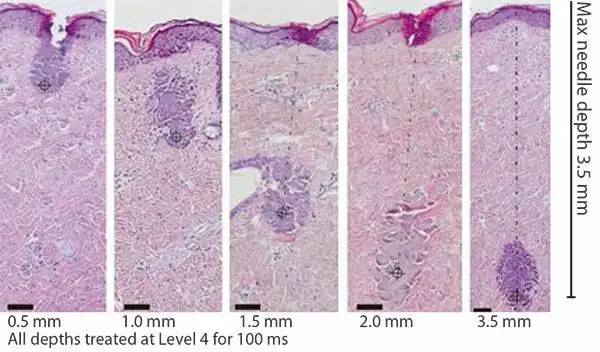
Figure 3 shows the Coagulation zone at a depth of up to 3.5 mm.
The latest technology, INFINI MFR, uses insulated needles (Gold Insulation) that can adjust to a depth of 3.5 mm and emit energy fractionally. This creates a very high Coagulation zone in the dermal layer of the skin, even at very deep levels, resulting in true fractional RF ablation. This results in highly effective treatment for both shallow and deep acne scars in a shorter period, reducing redness, tightening pores, improving overall skin laxity, and revealing smoother, brighter skin. This breaks the norm of traditional MFR tools, which often show minimal change. The recommended number of treatments is 3–5 for acne scars and 1–3 for enlarged pores to see significant improvement and rapid skin quality enhancement. It can be combined with Rejuran healer, with the peak results appearing at 4–6 months, when collagen reorganization is complete.
A single session of the Infinity Scar Klear & Rejuvenation program is equivalent to 3–6 sessions of conventional MFR (Micro-needle Fractional RF) due to the technique of targeting 3 different depths.
How does it differ from Fractora?
Fractora is also a fractional microneedling RF, but it does not achieve true fractional RF ablation. Even though the energy is emitted through the needle tip, it moves between the needle and the electrode on the upper layer of the skin. This makes it unpredictable whether the energy can cause heat and create a coagulation zone, especially in the dermis, which is directly related to acne scars. If the energy does not reach this layer, it affects the treatment’s effectiveness. Additionally, the wide energy spread can cause pain or twitching. Furthermore, the maximum depth of the Fractora needle is only 1.5 mm, which is not sufficient for treating deep acne scars or for significant skin lifting. In contrast, the Infini technology, an advancement over Fractora, not only has insulated needles to reduce obvious scabbing on the uppermost layer of the skin but also penetrates up to 3.5 mm deep, addressing deeper acne scars and offering concurrent skin tightening benefits.
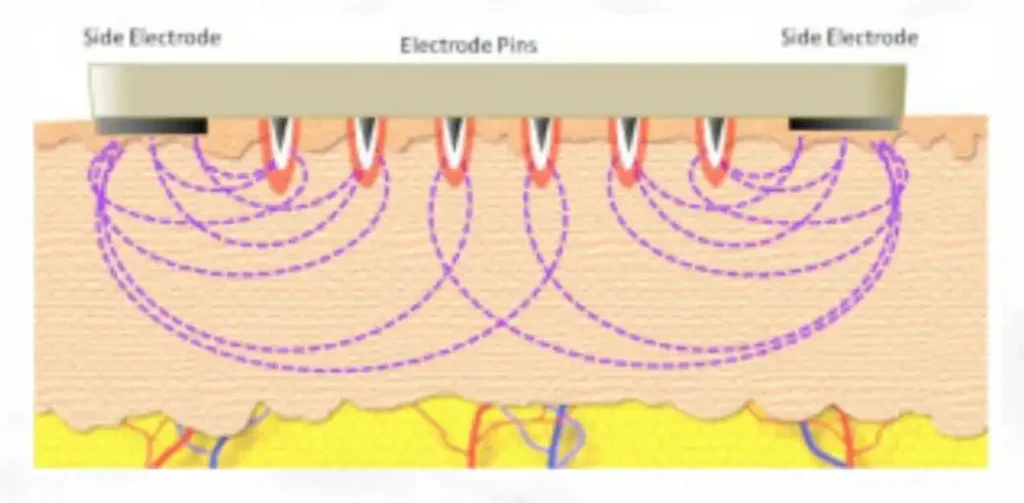
Figure 4 shows Fractora electrodes which are not insulated against heat and do not emit true fractional RF ablation energy.
The features of INFINI MFR in terms of skin lifting and reducing laxity are compared with ULTHERA.
Ulthera has three depth levels: 1.5mm, 3mm, and 4.5mm. The depth of 1.5 mm can reach the dermal layer, while the depth of 4.5 mm or the SMAS layer, which is mainly subcutaneous fat with little collagen, results in less coagulation with Ulthera. Additionally, upon completing Ulthera treatment, the number of coagulation points is approximately 7500–15,000 TPC’s, whereas Infini achieves up to 50,000 TPC’s or more, leading to better results in skin lifting beneath the surface at a lower cost per session.
In summary, skin lifting requires a crucial process known as coagulation injury (energy release causing injury around the release points), which must occur in the dermal layer only. It is observed that most tools releasing RF energy cannot precisely direct the energy nor ensure it reaches the dermal layer with enough intensity to cause coagulation injury. If this process does not occur, it explains why the treatment results might be unsatisfactory.”
Treat acne scars and wide pores, restoring smooth skin exclusively with the Acne Scar Revision technique at BAC Clinic. Book your appointment through LINE @bacclinic (click)
Testimonials
Before/After
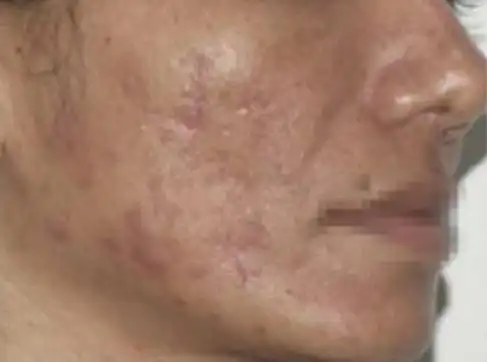
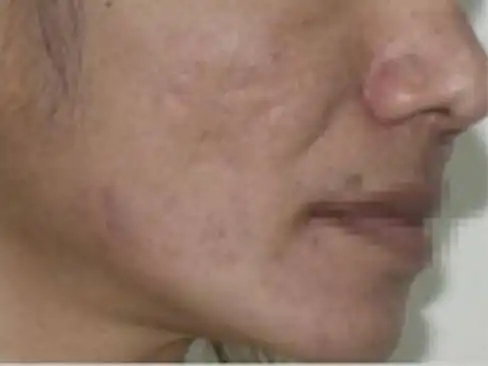
Before/After
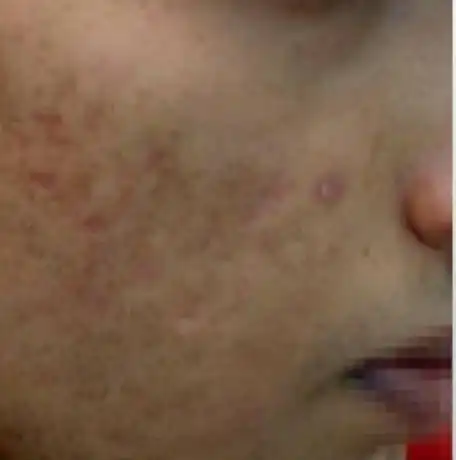
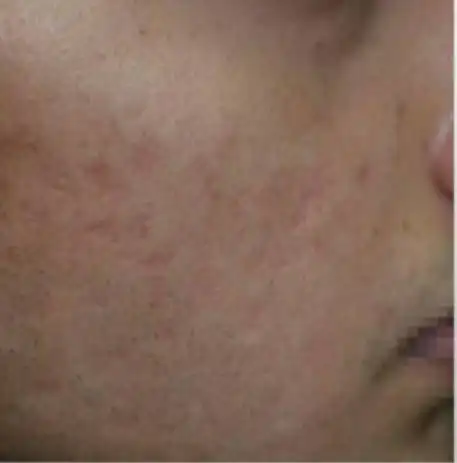
Before/After

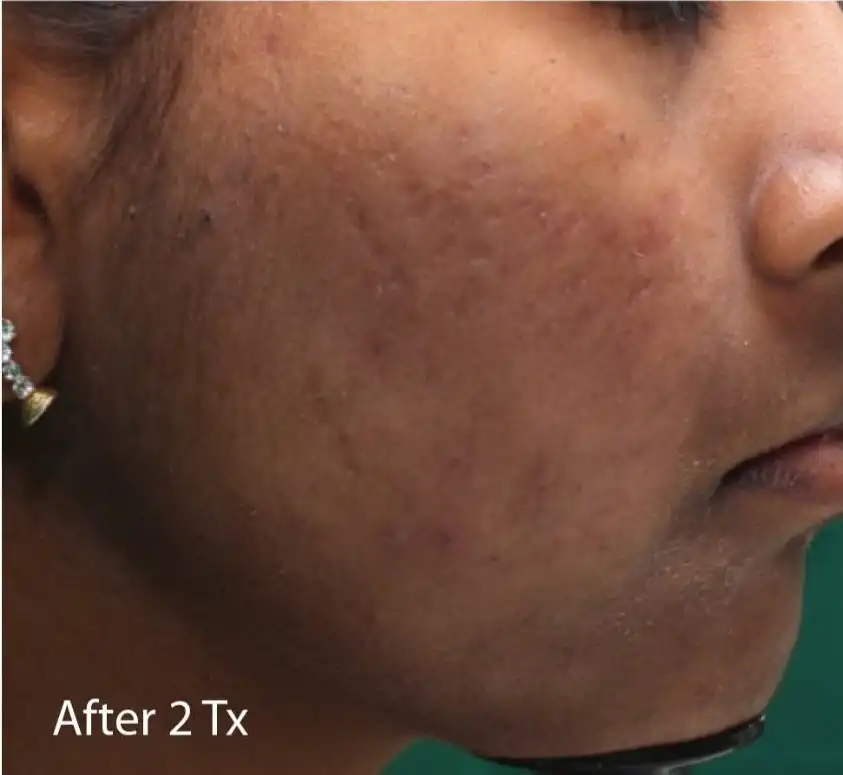
Before/After


Before/After




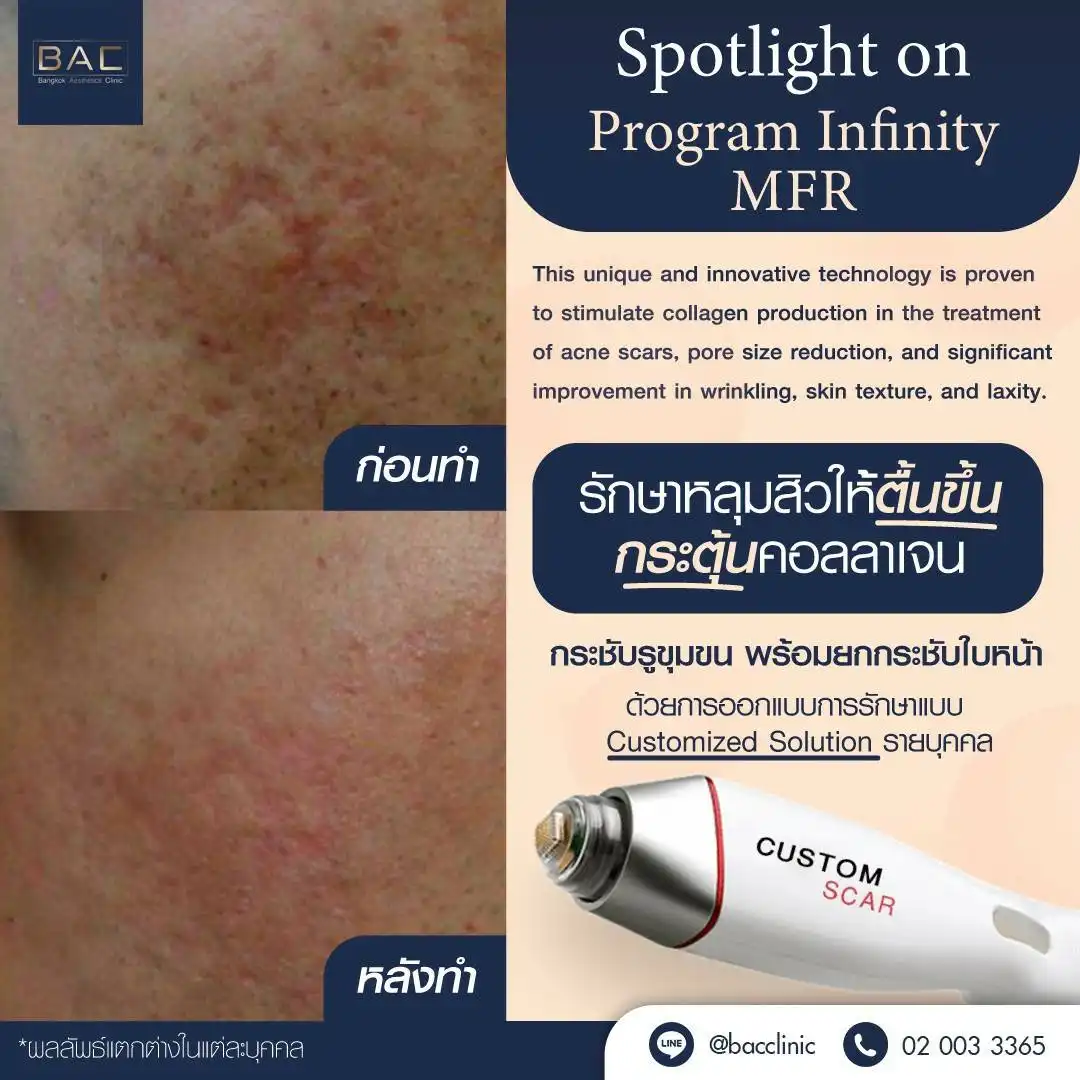
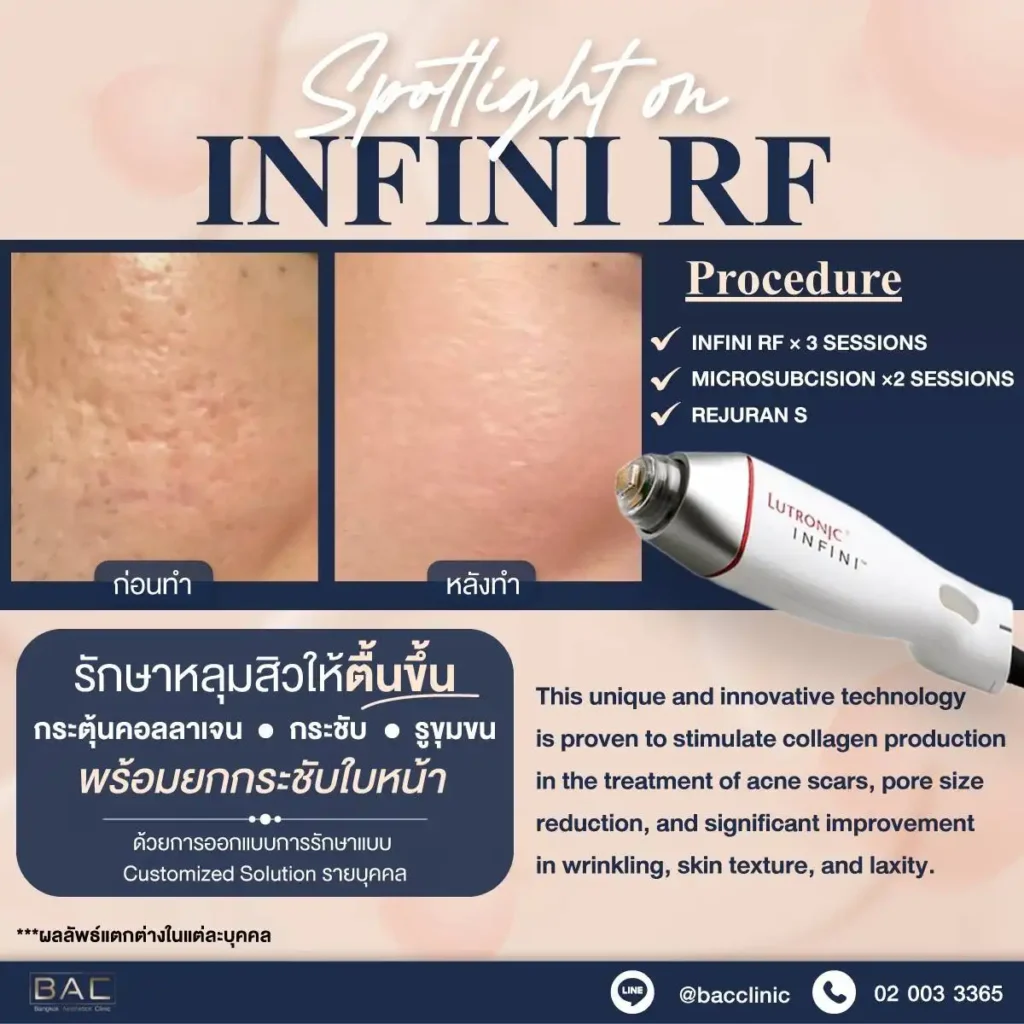
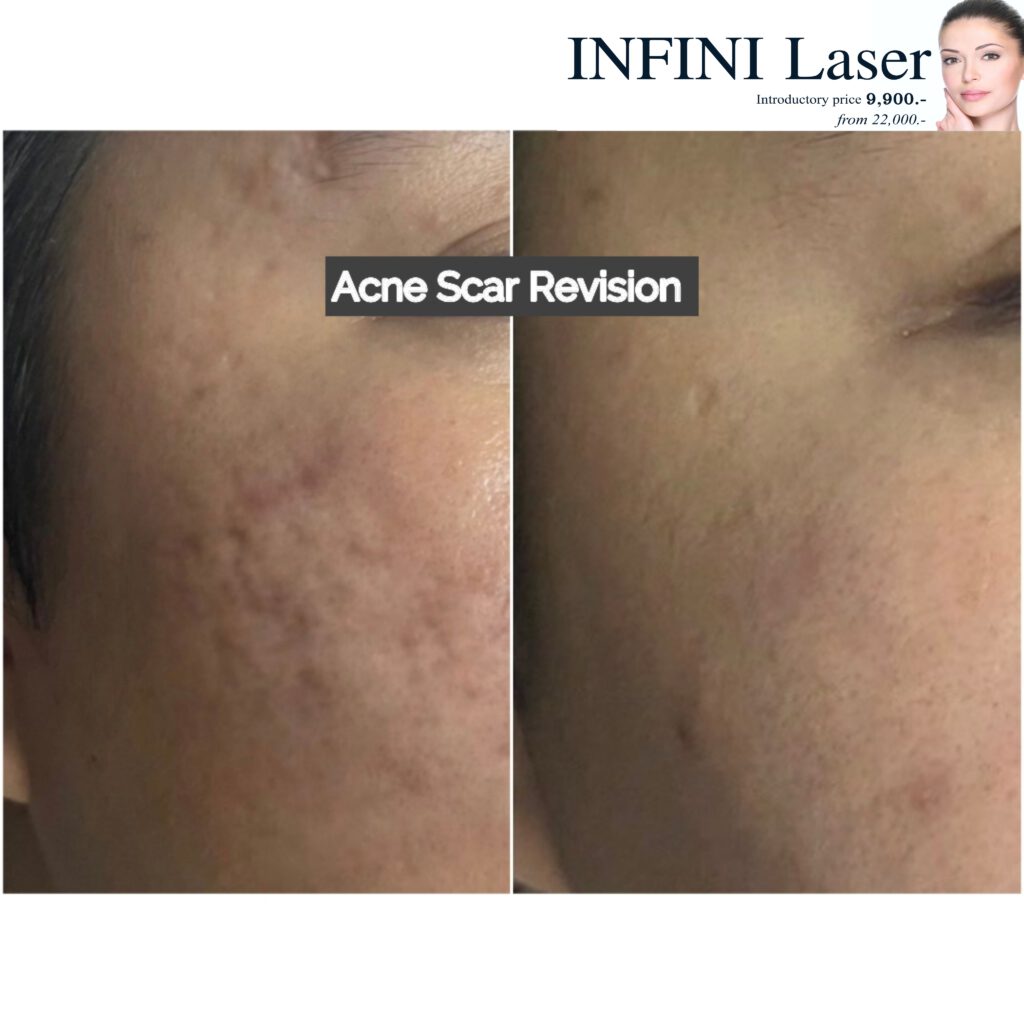

- Individuals with both deep and shallow acne scars, and those with post-acne redness.
- Acne scars are often the result of inflammation and improper care. A laser that can treat both shallow and deep scars effectively must be able to deliver energy to create a Coagulation zone in the dermal layer. This allows comprehensive treatment of scars, including redness, and noticeable changes can be seen after each session, continuing for 4–6 months.
- People with wide pores, which can be caused by inflammation under the skin from acne, improper care, or excessive oil production. Advanced Micro needling RF with a 49-pin needle can adjust the layer level according to each skin layer’s problem, and stimulate true ablative injury (unlike regular Microneedle which doesn’t reach the dermis), leading to collagen renewal and reduced oil production, a factor in wide pores.
- Those with wrinkles and skin laxity, as collagen and skin elasticity naturally decrease with age, leading to drier skin, more visible acne scars, and wide pores. INFINI, combined with Rejuran healer or Cellular matrix, should be administered by a specialist.
- Acne scars and scars will become shallower.
- Dark and red acne spots will fade, leading to brighter, clearer skin, reducing melasma, freckles, and dark spots.
- Wrinkles and skin laxity on the face will diminish.
- Pores will appear tighter, and the skin will become smoother and more youthful.
- Results may vary among individuals.
Post-treatment care for the Infinity Scar Klear & Rejuvenation program:
- Expect some swelling and redness, which will gradually reduce in 3–4 hours and normalize.
- Avoid washing the face for about 24 hours, or use saline water instead.
- Makeup can be applied the following day.
- Avoid direct sunlight, hot places, and saunas for about a week.
- Avoid skin-irritating products like AHA and vitamin A for the first week.
- Use gentle facial products and keep the skin moisturized.
- Protect the skin with SPF 50 sunscreen, reapplying throughout the day.
The difference between red and dark spots from acne and acne scars?
- Red and dark spots from acne, known as Post-inflammatory hyperpigmentation (PIH), can disappear on their own and are temporary. These spots can fade naturally within 4–8 months. However, acne scars, or pitted acne scars, cannot heal by themselves and have a lasting effect.
What causes pitted acne scars?
- Pitted acne scars often result from inflammatory acne types such as papules, pustules, and cystic acne. Severe skin inflammation from acne and pus-filled lesions can destroy the collagen in the skin’s underlying layers. This is particularly true for the most severe form, cystic acne, which is deep-seated and inflamed, caused by bacterial infection deep in the skin. This results in infected, inflamed fat pockets, characterized by large, hard, pus-filled nodules. The worst outcome, especially when squeezed, is severe acne leading to natural wound healing processes that form scar tissue. This scar tissue pulls the skin inward, and since the skin can’t regenerate collagen effectively in that area, it fails to refill properly, resulting in “scars.”

The severity of acne scars is indeed correlated with the severity of the acne itself. There are various types of acne scars, with atrophic scars, or depressed acne scars, being a common category. These atrophic scars can be further classified into different types, including:
- Ice Pick Scars: These are deep, narrow, pitted scars that look as if the skin has been punctured with a sharp object. They are usually small in size but quite deep, making them harder to treat.
- Boxcar Scars: These scars are broad with sharply defined edges, similar to chickenpox scars. They can be shallow or deep and are often found on the cheeks and temples.
- Rolling Scars: These scars create a wave-like or rolling appearance on the skin due to their wide and shallow depth. They are caused by fibrous bands of tissue that develop between the skin and the subcutaneous tissue below, pulling on the epidermis.
- Mixed Scars: In many cases, individuals may have a combination of different types of scars, which can complicate treatment as each scar type may require a different approach.
Understanding the type of acne scar is crucial in determining the most effective treatment approach. Each scar type has unique characteristics and may respond differently to various treatment modalities.

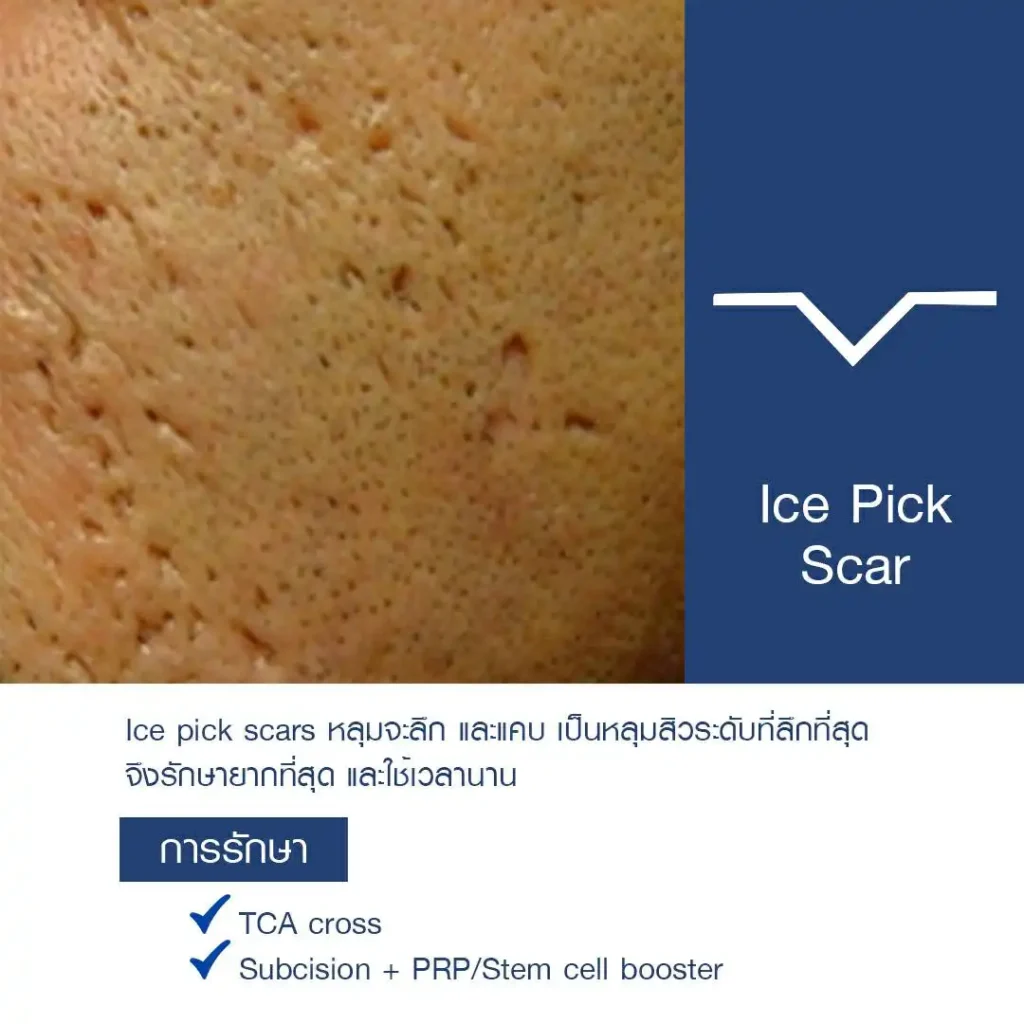
Frequently Asked Questions:
- Cost of Treating Acne Scars
The cost varies depending on the type and severity of the acne scars. This variation is due to differences in treatment methods, the number of sessions required, and the tools used.
- Treatment for acne scars starts from 500 THB. Details are as follows:
- Microsubcision using Blunt Cannula Subcision (Multilayer technique)
- This technique immediately releases scar tissue adhering to the deeper structures of the facial anatomy.
- Blunt Cannula is more effective than using traditional needles.
- Blunt Cannula causes fewer side effects compared to Nokor needles or blade-like needles used in traditional Subcision.
- This procedure can be combined with other treatments targeting acne scars, such as laser treatments and Microneedling RF (Infini MFR).
- The recovery time after Subcision with Blunt Cannula ranges from 2–10 days.
- This procedure is performed under local anesthetic block.
- The Microsubcision Program (Blunt Cannular Multilayer) involves the meticulous dissection and cutting of fibrous bands across the face, sometimes referred to as acne scar surgery. It is a method for treating acne scars by cutting the fibrous bands using specialized small needles, capable of cutting fibrous bands of all types. This technique causes minimal pain and may result in slight bruising, with visible results evident from the first session.
- 📍Service fees
- when combined with Picosecond laser or Infini MFR: 👉 500 THB per spot/1,500 THB for the entire face.
- When not combined with Picosecond laser or Infini MFR: 👉 900 THB per spot/2,900 THB for the entire face (standard price when not combined with laser)
Remember, it’s important to consult with a qualified healthcare professional to understand the best treatment plan for your specific case, considering the type and severity of your acne scars.

- Microneedle Fractional RF (Infini MFR, USFDA standard): Starting at 9,900 THB. This includes mesotherapy for acne scars (PDRN), anti-inflammatory light therapy, local anesthetic marking, and post-laser nourishing cream. There are no additional charges unless previously informed to the patient. Patients receive an assessment and treatment plan from a qualified physician.
- Rejuran Healer and Rejuran S:
- Rejuran Healer 2cc: 8,900 THB.
- Rejuran S 1cc: 9,900 THB.
- Rejuran Healer 2cc + Infini MFR: 16,900 THB.
- Rejuran S 1cc + Infini MFR: 17,900 THB.
It’s important to note that the prices may vary depending on the clinic and region. Consultation with a healthcare provider is crucial to understand the best course of treatment for individual needs and skin conditions.
The treatment of acne scars varies depending on the individual, the type, and the severity of the scars. For impressive results, it’s often recommended to combine multiple treatment methods, especially if there are more than one type of scar on the face.
- For Ice Pick Scars and Narrow Boxcar Scars: TCA CROSS is effective. This technique uses high concentration TCA to stimulate sub-scar tissue, promoting new collagen formation to ‘fill in’ the pitted scar. It works better for deeper scars, with collagen stimulation taking at least 3–4 weeks to start new collagen formation and up to 3–4 months for maximum results. Therefore, a treatment gap of 5–8 weeks is recommended with 2–5 sessions for optimal results. The recovery time is 5–7 days, and the procedure takes 5–30 minutes, performed by a doctor. The cost ranges from 500 to 1,990 THB.
- For Rolling Scars: Fractional lasers and micro-needling fractional RF (Infinity Scar Laser) are effective. These treatments have shorter skin cell repair times compared to fractional lasers, usually around 48 hours, and are safe with a lower chance of PIH, providing continuous improvement for 4–6 months.
- Picosecond Laser: This latest non-ablative laser delivers precise energy, offering safe results with low downtime. It’s ideal for patients who want minimal recovery time and focuses on rejuvenating collagen under the skin, tightening pores, and brightening the skin. It is suitable for superficial acne scars and skin beautification without significant downtime. The Pico BB Smooth program at BAC Clinic is continuously popular, offering effective results for minor skin imperfections.
- For Scars Caused by Tethering of Scar Tissue: Micro-subcision (a quick recovery technique at BAC) is recommended, ideally combined with lasers, micro-needling fractional RF (Infinity Scar Laser), and Picosecond Laser. This technique helps release the scar tissue, allowing the skin to smooth out more effectively.
Each treatment method targets different types of scars and works by stimulating collagen in various ways. It’s important to consult with an Acne Scar Specialist to determine the most appropriate combination of treatments for individual scar types and skin conditions.
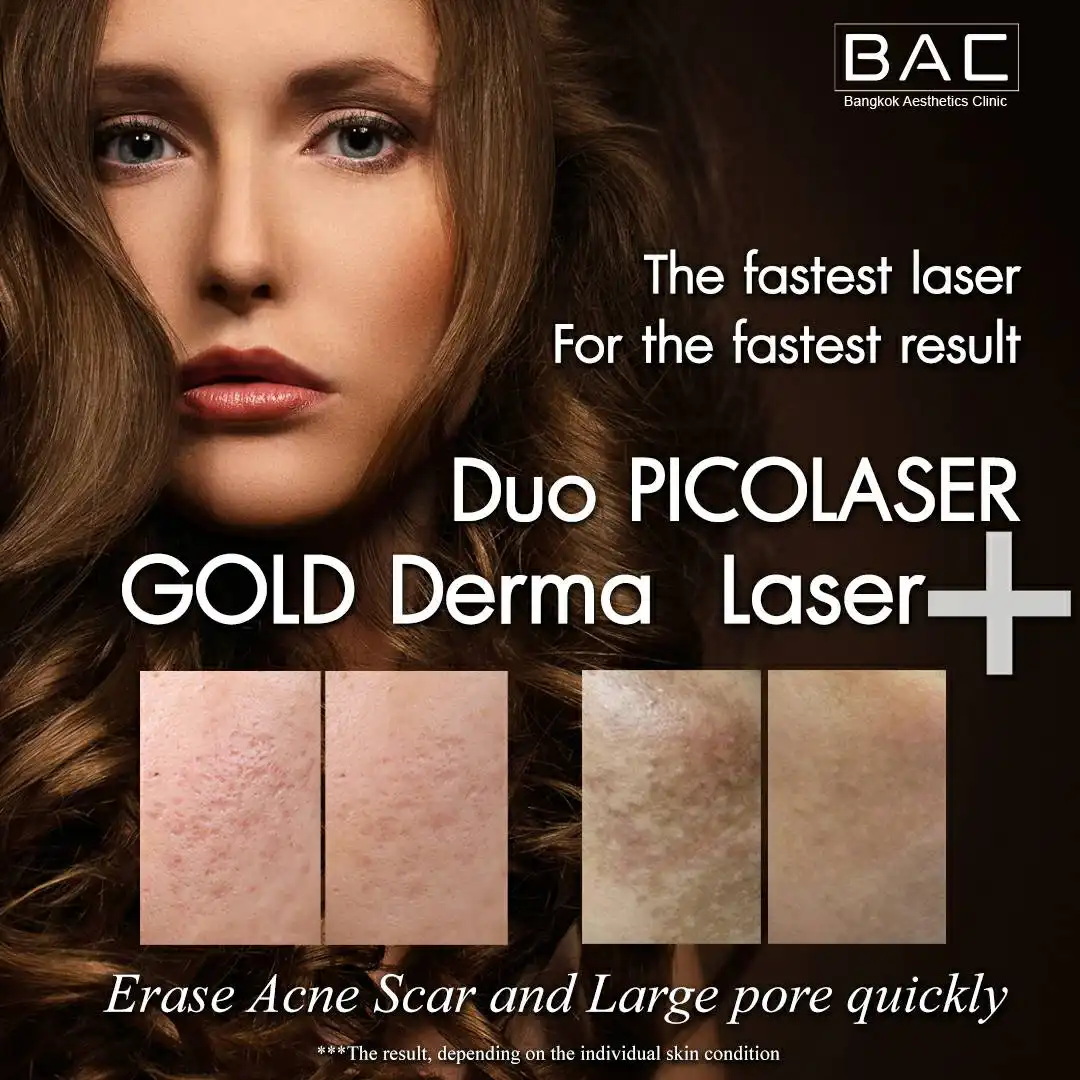


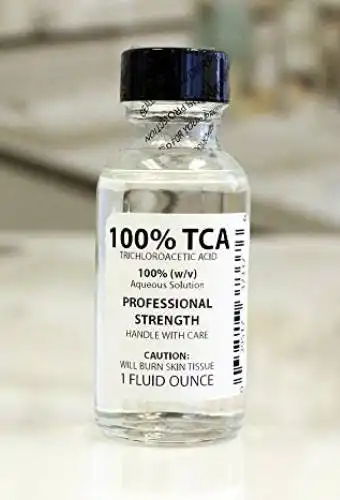

- TCA CROSS and TCA paint (TCA Chemical Reconstruction of Skin Scars):TCA CROSS is a technique using high concentration TCA (Trichloroacetic Acid) to specifically target acne scars. It involves using a toothpick or a small needle to apply TCA directly into the scar. TCA stimulates collagen production and encourages the reorganization of collagen fibers, effectively treating even deep ice pick scars.
TCA Cross/TCA Paint for Enhancing Effectiveness with Other Procedures:
📌 Number of sessions for optimal results: 2–5.
💃 Recovery time after treatment: 5–7 days.
🧑🔬 Duration of the procedure: 5–30 minutes. 1
🧑⚕️ Performed by a medical doctor.
⏳ Duration of results: Permanent.
💵 Cost: 500–1,990 THB.
- Used in the treatment of acne scars to stimulate the sub-scar tissue to thicken and permanently plump up.
- TCA creates ‘new wounds from old ones’ — meaning TCA dissolves the acne scar and destroys collagen, leading to new collagen stimulation to ‘fill in’ the pitted scar. Deeper scars respond better to this stimulation. It takes at least 3–4 weeks to build new collagen and up to 3–4 months to achieve maximum results. Therefore, a gap of at least 5–8 weeks is recommended between treatments.
Facts about Acne Scars Treatment with TCA Cross — Paint:
- One of the best treatments for ice pick scars.
- TCA can be used on narrow and deep boxcar scars.
- Can be performed using a needle or a toothpick.
- This is a form of chemical peel focusing only on the problematic areas.
- Should be combined with lasers, radiofrequency, and other scar treatment methods for the best results.
Cost for TCA CROSS treatment:
- Combined with Pico laser or Infini MFR at specific spots: 500 THB; full face: 1,200 THB.
- Without combining with Pico laser or Infini MFR: specific spots: 800 THB; full face: 1,990 THB
The advantages of TCA CROSS are:
- The treatment for deep acne scars, which are often difficult to heal and unresponsive to laser treatments, typically sees an improvement of 30–40% in the depth of the scars in just one session. These treatments can yield impressive results if performed by a specialist. With just 2–5 sessions over a period of 3–6 months, maximum outcomes can be achieved.
- This method is relatively painless with a quick recovery time. However, post-treatment care is crucial, especially avoiding direct sunlight for at least two weeks. This precaution helps to prevent any potential post-inflammatory hyperpigmentation (PIH) and ensures optimal healing of the treated area.
- It’s important to have realistic expectations and understand that while significant improvement can be achieved, complete eradication of deep acne scars may not always be possible. Each treatment session helps to progressively improve the appearance of the scars, making them less noticeable and smoother over time.
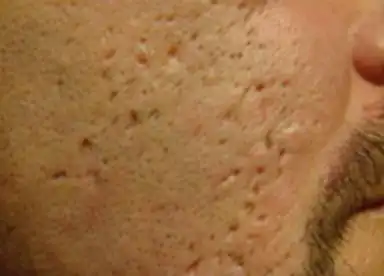
Figure 7 shows Ice Pick scars responding well to treatment with TCA CROSS.”
Filling acne scars with Fillers such as Juvederm, Restylane, Belotero,Rejuran S, Rejuran healer, and Bubbles DNA:
The advantage of using fillers for acne scar treatment is that they don’t just provide a temporary or superficial filling. While fillers do offer some degree of improvement by filling in the scars, their primary benefit lies in stimulating collagen production from the base of the scar. However, this improvement is usually modest.
In contrast, using products like Rejuran or Bubbles DNA (2% Polyneucleotides), which are top-rated in treating acne scars, can regenerate, repair, and stimulate new collagen production simultaneously. The collagen produced by the skin cells themselves is not just a temporary solution introduced through fillers, making the results more permanent.
This approach addresses the underlying issue of collagen loss in scarred areas, leading to more sustainable and long-lasting improvements in the appearance of acne scars. It’s important to consult with a dermatologist or a medical professional to determine the most suitable treatment option based on the individual’s skin type and scar severity.
What You Should Know About Using Fillers and Treating Acne Scars:
Can fillers be used in conjunction with laser and other treatments?
It depends on the level of filling and depth of treatment. Generally, fillers are placed in the fat layer and the lower dermis. In the case of Fractional lasers, which can reach depths between 0.2 to 0.8 millimeters, they don’t reach the filler level. However, if deeper treatments are done using needles with radiofrequency waves (like Infini MFR), the filler is not affected by energy-based devices such as lasers, radiofrequency, and HIFU. This is because fillers can remain stable at temperatures above 110 degrees Celsius for more than 7 minutes, while energy-based devices can only heat up to 69 degrees Celsius for a fraction of a second. Nevertheless, to be safe, it’s recommended to do filler injections in subsequent sessions to minimize other factors.
Atrophic acne scars are caused by the loss of collagen and fat in the area.
Fillers used in the dermis are used to increase volume in patients who are unlikely to resolve volume depletion on their own.
Volume depletion acne scars, or the loss of collagen and fat volume, can be filled with filler injections.
Fillers for acne scars help to achieve the expected volume correction and can last for varying durations, depending on the type and the patient’s lifestyle.
Fillers injected into the dermis are another group that helps stimulate collagen production.
Fillers are also used to correct volume loss acne scars caused by aging, which become more apparent in older patients with acne scars from tissue and fat depletion.
Fillers are used in conjunction with other scar treatments, including lasers like Pico lasers, and radiofrequency microneedling.
Which type of acne scars are treated with fillers?
Fillers help correct sunken acne scars, such as rolling scars, boxcar scars, and irregularly shaped acne pits.
Why use fillers?
In the context of correcting acne scars, dermal fillers serve to fill the sunken areas of the skin (Atrophic acne scars). These fillers are particularly useful for scars that have lost volume due to collagen and fat loss.
Since lasers and radiofrequency microneedling only serve to generate new collagen and do not help create new fat layers, fillers are used for acne pits that have sunk due to fat loss. Moreover, fillers also stimulate collagen production, aiding in the correction of small to medium-sized acne scars that penetrate deep into the dermis.
How do fillers stimulate collagen production?
Hyaluronic acid (HA) fillers, such as Restylane®, Juvederm®, Belotero®, have many benefits in maintaining youthfulness, such as reducing facial wrinkles and restoring lost volume. Did you know that these fillers also stimulate your body’s collagen production?
Fillers do more than just fill! They also stimulate collagen production. A 2007 study in the Archives of Dermatology found that new collagen was produced in the areas treated with fillers in just a few months after treatment.
Researchers injected fillers into study participants, then performed skin biopsies called punch biopsies at 4 and 13 weeks post-treatment to analyze skin composition. The results were fascinating!
Not only was the filler present in the skin samples, but there was also a significant amount of newly produced collagen, more than the researchers had anticipated. So, how was all this new collagen produced? Researchers believe the answer lies in cells called fibroblasts.
When we are young, we have long and strong collagen fibers that form the structure of our skin. Fibroblasts cling to and stretch along these fibers to produce new collagen to replace old, deteriorating collagen.
However, as we age, this process diminishes. Excessive sun exposure is a primary cause of the destruction of this collagen renewal process, but some of it is due to the natural wear and tear of collagen fibers and fibroblasts. The result is that fibroblasts stretch less and collagen production slows significantly, or in some cases, stops altogether.
So, how do fillers address this issue? Researchers felt that if they could stretch the fibroblasts again, they might restart the body’s natural collagen production process. They discovered that fillers act like subcutaneous collagen fibers, creating a structure similar to that naturally produced by our collagen. As they hoped, researchers observed that fibroblasts stretched along the fillers, just as they do along collagen fibers, and the collagen production process began anew.
Filler program for acne pits
Filling acne pits with hyaluronic acid fillers helps to plump up the pits, hydrate the skin, and reduce pore size without the need for recovery time or scarring. Suitable for those who need quick results, skin appears smoother immediately after the procedure.
Promotion
1 cc 12,900 baht, down from 18,900 baht
2 cc 23,900 baht
Subsequent cc 11,000 baht
How much filler is used for acne pits?
The amount of filler used varies by individual, but typically it’s about 1–2 CC. At BAC Clinic, the technique involves using 2 CC, and patients should consult a doctor beforehand to determine the appropriate amount.
The fillers used at BAC Clinic for acne pits are Restylane or Belotero revive, which can show immediate results of about 70% (*varies by individual) and also stimulate subcutaneous collagen, hydrating the skin and reducing pore size. This method differs from others as it requires no recovery time or scarring. However, it’s not a permanent treatment; one treatment lasts about 6 months to a year, depending on the brand used. When the filler dissolves, it can be re-injected to maintain results.
Steps for filler injection for acne pits
Consult with a doctor and plan the treatment, where the doctor will recommend the appropriate filler brand and amount for the patient’s acne pit issues.
Before the filler injection, the doctor will unbox the filler in front of the patient, who can check for authenticity.
Before injection, there may be a cold compress and topical anesthetic application.
In cases of acne pits that need to be released from fibrosis, the doctor will perform the procedure before injecting the filler.
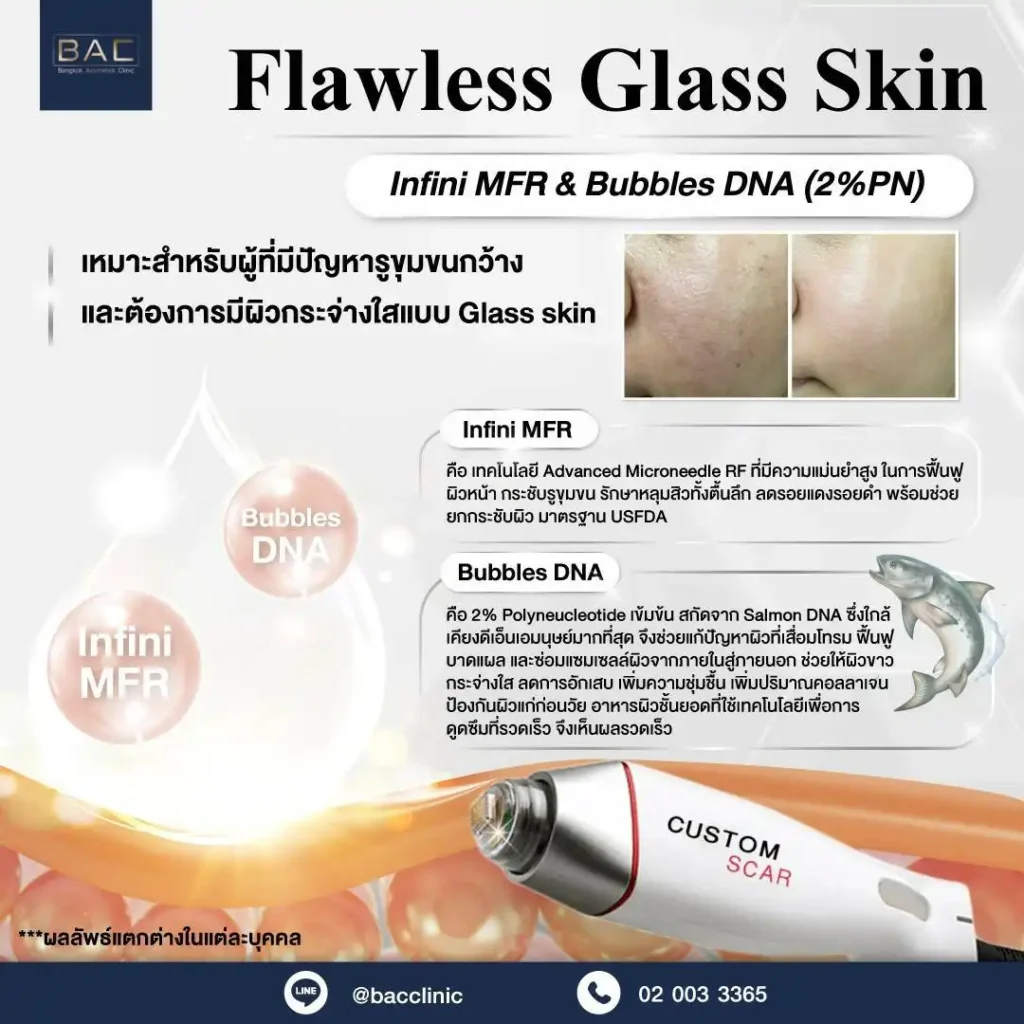

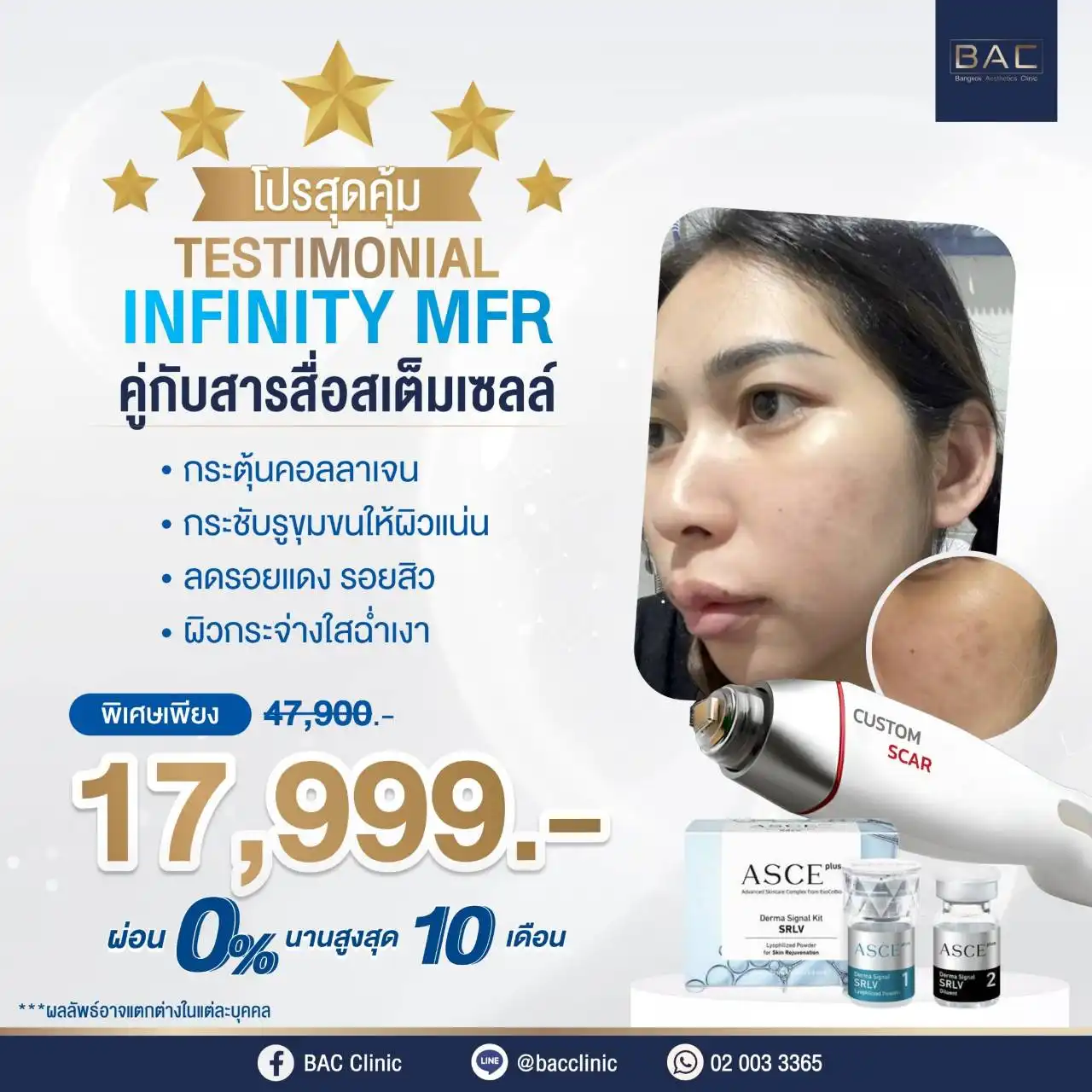
Can the Infinity Scar Klear & Skin Rejuvenation program treat wide pores?
Yes, it can treat wide pores effectively because it creates a distinct Coagulation zone beneath the skin layers, which leads to a significant production of new collagen. This differs noticeably from standard MRF treatments as it can reach every skin layer and deliver energy to create real subdermal injuries, impacting the new collagen formation, resulting in skin that is tighter, finer, and more firm.
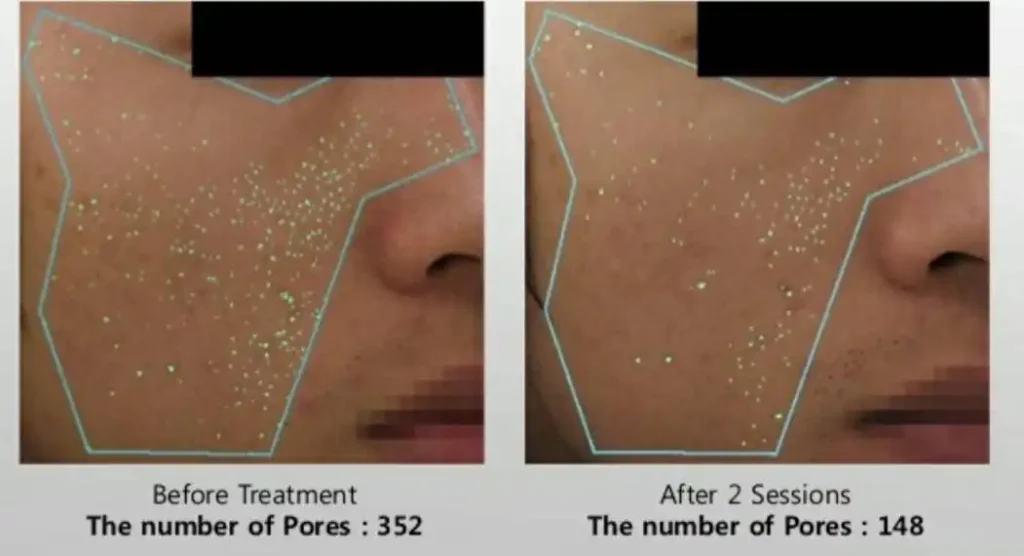
Figure 8 shows a noticeable reduction in the number of pores. The image demonstrates that after treatment with the Infinity Scar Klear & Rejuvenation program, the number of pores reduced from 352 to 148 pores.
In treating acne scars, there are several important things to know:
Importance of Personalized Treatment:
- There’s no one-size-fits-all approach for acne scar treatment. Effective and goal-oriented treatment requires multiple methodologies, especially if you have different types of scars like ice pick scars, boxcar acne scars, and rolling scars. A comprehensive and precise treatment plan is necessary for each type of scar on the face. BAC Clinic offers a variety of targeted treatments that align with each patient’s lifestyle.
Restorative Skin Treatment for Acne Scars:
- Generally, more than one treatment session is needed, depending on the severity of the skin issue. The reorganization of scar tissue requires time and multiple sessions to stimulate enough collagen production to visibly improve the scars. However, more effective tools and specific techniques can lead to clear results in just one session, with additional sessions enhancing the outcome.
Best Acne Scar Treatment in 2024:
- The advancements in acne scar treatment have been significant. Today, options like Cellular Matrix, Exosome and Biostimulator are used for rejuvenation and filling scars, a leap from the initial era of ablative CO2 lasers. The key to the best treatment in 2024 is not just about the type of laser or filler but about personalized treatment plans tailored to the specific type of acne scar. BAC Clinic focuses on providing “The best you can afford” from various options, allowing patients to be part of the decision-making process with minimal limitations.
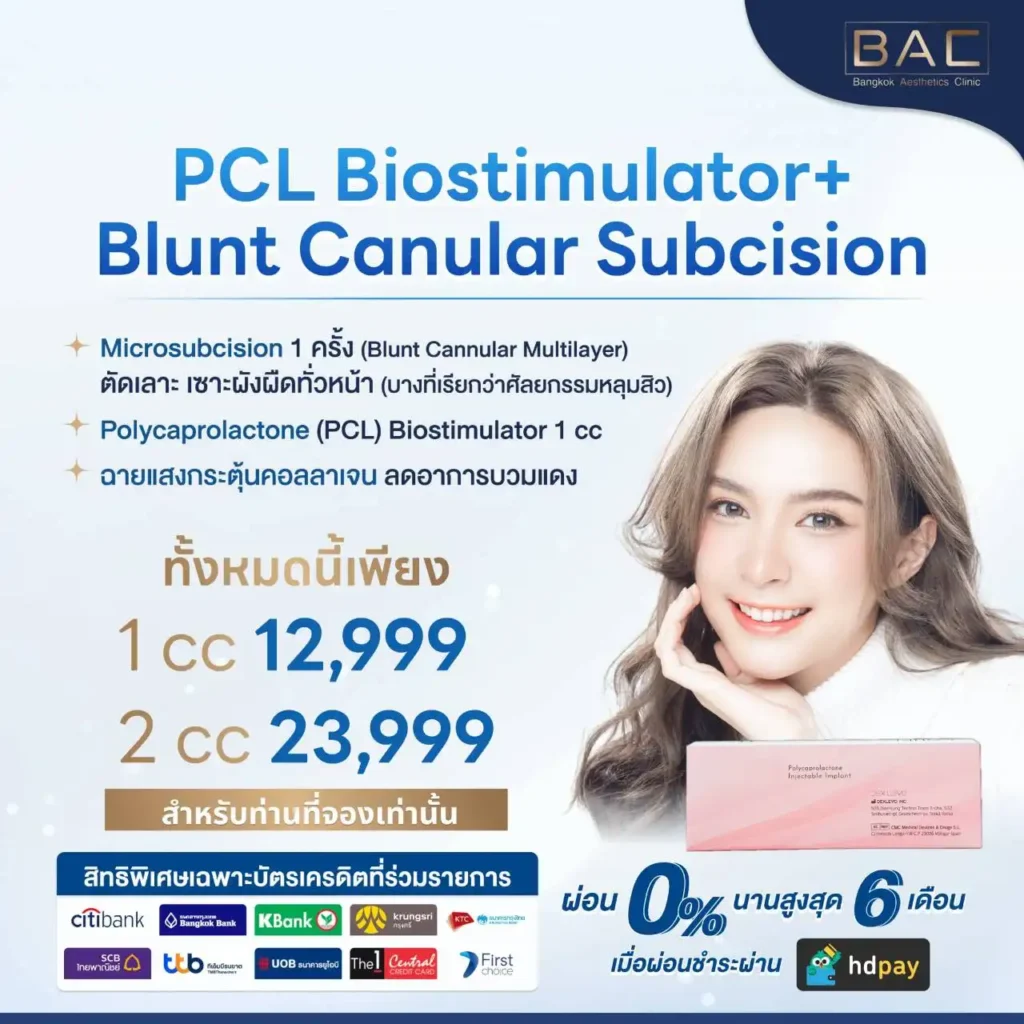
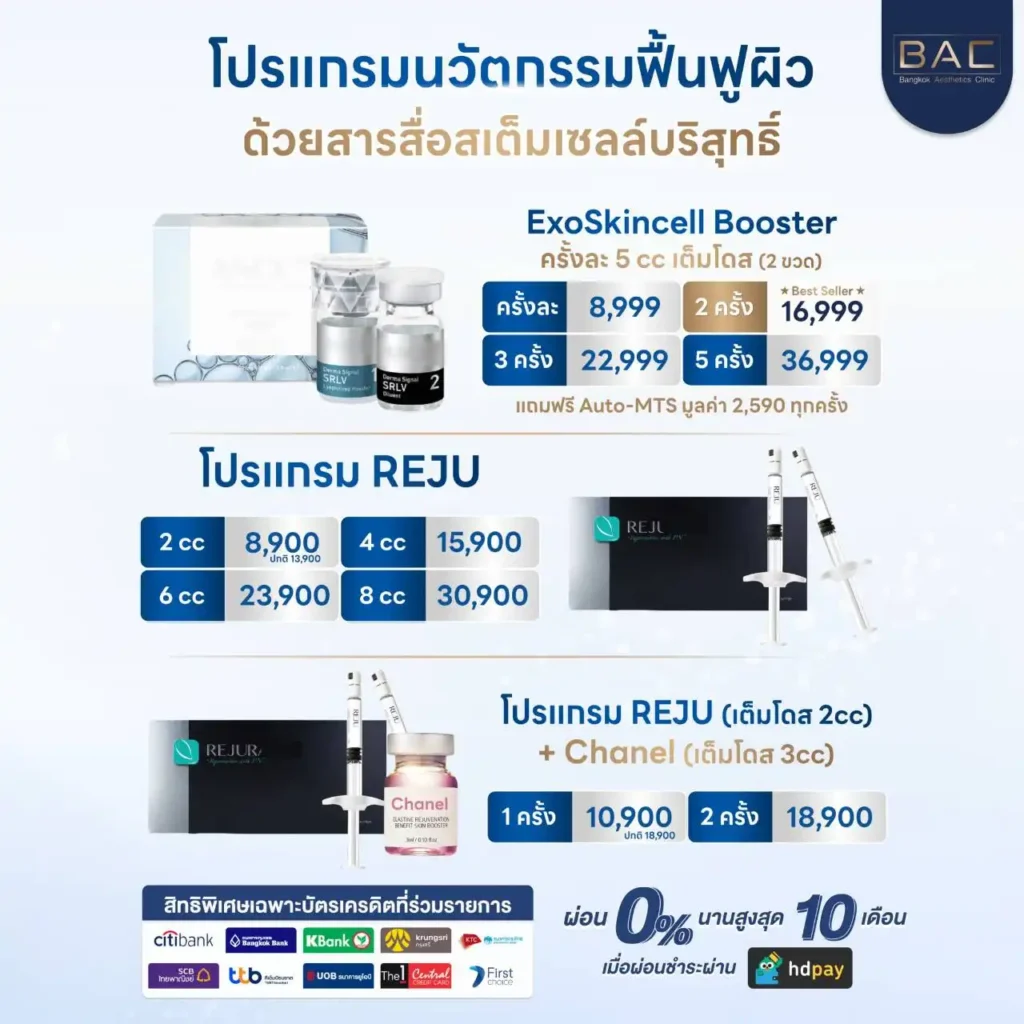
Advanced Microneedling Fractional RF for Acne Scars:
- The treatment results improve gradually after each session, with visible results typically from the first session. For more significant outcomes, at least 3 sessions are recommended, spaced 4–6 weeks apart, depending on skin condition and the doctor’s discretion.
- About 2–4 weeks post-treatment, patients will notice tighter pores, shallower acne scars, and smoother skin. Collagen production continues for another 4–6 months, with results varying among individuals. Additional treatments like microsubcision or subcision may be needed for complete results.
- Aftercare includes gentle cleansing on the first day, with regular washing and skincare resuming the next day.
Spacing Between Treatments:
- Typically recommended at 2–4 weeks intervals, depending on individual needs, severity of the problem, patient’s goals, and recovery time. For those with minor pore issues and shallow scars, downtime is very short (about 8–12 hours), allowing for makeup application the next day. For more severe cases, swelling and redness can last about 24 hours, with improvement within 3–4 days.
- Consideration of scab shedding is also important. Although INFINI uses very small needles, causing almost invisible scabbing, it’s advised to wait for the complete shedding of scabs (about 5–14 days) before undergoing another session.
The energy level, depth, and number of passes in each session are adjusted for a customized solution, which means the timing for subsequent sessions may vary. For instance, higher energy levels may require a longer interval of 4–6 weeks before the next session.
“An important aspect in treating acne scars (Acne Scar Revision) and minimizing large pores is not just about reviewing before-and-after photos, as these can easily be edited or might only show temporary redness from acne which is easier to treat than actual scars. Therefore, patients should thoroughly research the cosmetic laser tools to determine if they can genuinely address their specific issues. Additionally, the expertise, knowledge, and understanding of the physician in selecting and using these tools to target the problem areas are crucial. Patients must consider these factors because concerns extend beyond ineffective treatment to potential side effects, such as melasma, burnt skin, or thinning of the skin. Especially with tools like the Co2 Laser, which penetrates the upper skin layer with heat — different brands may share the same principle but do not guarantee identical results. Hence, patients should actively seek information to ensure satisfactory treatment outcomes without incurring unnecessary costs.”
Expert Doctor Specializing in Treating Melasma and Dark Spots in Bangkok

Darks spots, moles, or hyperpigmentation are conditions where certain areas of the skin become darker than usual or develop excess pigmentation in those areas, resulting in an uneven complexion with dark patches that are difficult to conceal. While not necessarily severe, these conditions can significantly impact confidence and self-image, often requiring constant cosmetic coverage. Both internal hormonal factors and external environmental conditions contribute to the onset of these conditions. Therefore, understanding the causes and treatment options can help individuals make better decisions in self-care and prevention.
What are melasma? Melasma are a common dermatological condition caused by the overactivity of melanocytes, the cells responsible for producing pigment in the skin. This leads to an increase in localized pigment production (hyperpigmentation), resulting in darker patches, especially prominent on the face and sometimes on the neck, chest, and arms. Freckles are most prevalent among individuals with Fitzpatrick skin types III-IV, commonly found in Asian populations. They appear as light to dark brown spots or patches and are more frequently observed in women than in men, with a ratio of 9:1.
The exact cause of melasma remains unclear, but it is believed to be associated with the overactivity of melanocytes beneath the skin’s surface. Freckles occur due to an increased melanin production, with melanocytes in affected areas having longer dendrites and a higher concentration of melanosomes in stages III and IV, both in epidermal and dermal melanocytes. Factors that increase the likelihood of freckles include Asian ethnicity, particularly Fitzpatrick skin types III-IV, female gender, sun exposure, hormonal changes such as during pregnancy or with contraceptive use, genetics, thyroid disorders, and low levels of testosterone.
In summary, understanding the factors contributing to the development of freckles can help individuals take proactive measures to manage and prevent these conditions, thereby improving their self-care and confidence.
Periorbital hyperpigmentation, also known as dark circles under the eyes, occurs due to the thinness of the periorbital skin, leading to the visibility of blood vessels, hollows, and shadows. Accumulation of melanin in the dermis, post-inflammatory hyperpigmentation (PIH) resulting from conditions like allergic contact dermatitis, etc., can contribute to its formation. Treatment options for periorbital hyperpigmentation include topical medications such as hydroquinone, kojic acid, azelaic acid, etc., as well as various procedures like chemical peels, radiofrequency, fractional laser, picosecond laser, filler injections, fat injections, etc.
Freckles, also known as ephelides, are small, flat, brown spots that appear on the skin due to increased melanin production. They are commonly found on sun-exposed areas of the skin and are usually harmless. Freckles may be treated with topical creams containing ingredients such as hydroquinone, retinoids, or azelaic acid, or through procedures like chemical peels, laser therapy, or cryotherapy, depending on the individual’s preference and severity of the freckles.
Ephelides, freckles

(Ephelides (Freckles) — Dermatology Advisor, n.d.)
These are light brown patches with distinct borders, typically larger than 5 millimeters in size, commonly found in areas exposed to sunlight such as the face, back of the hands, and arms. This condition is more prevalent in individuals with fair skin compared to those with darker skin tones. Prolonged sun exposure tends to darken these spots and may contribute to their increased occurrence.
Solar lentigo, actinic lentigo, sun spot, senile lentigo
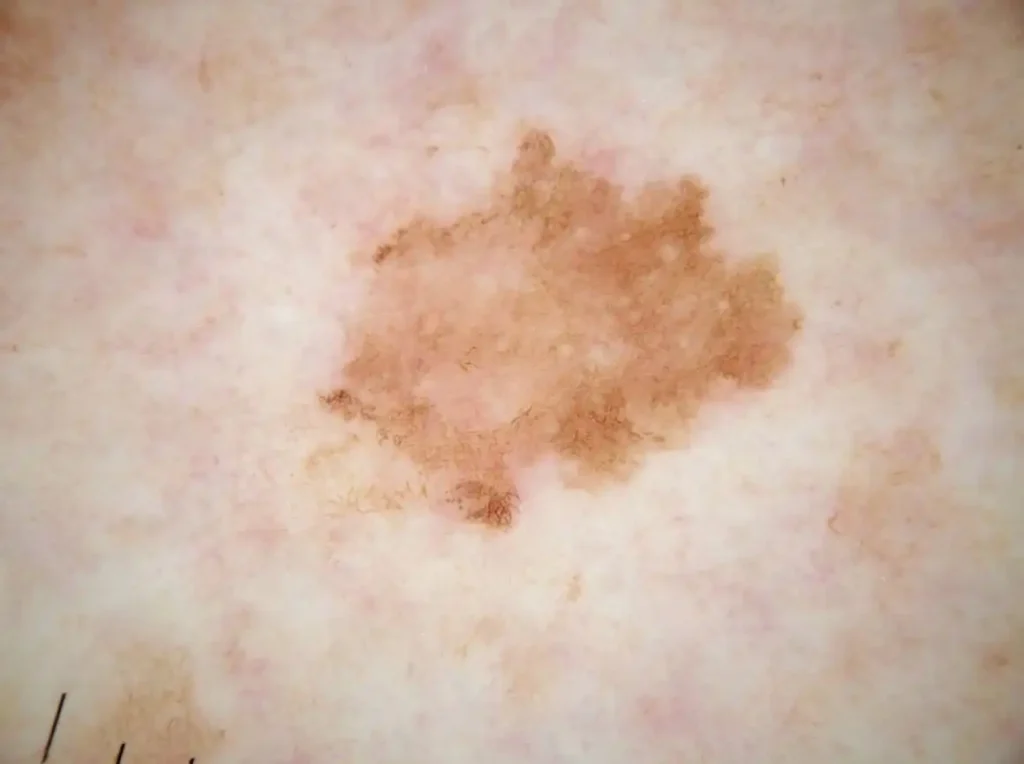
(Solar Lentigines — Dermoscopedia, n.d.)
Due to sun exposure, freckles are commonly found on sun-exposed areas such as the face, upper chest, back of the hands, and arms, often seen under shaded areas of clothing exposed to sunlight. Initially, freckles tend to be smaller than 5 millimeters in size, with a light brown color that may darken over time. Freckles usually increase in number gradually and may enlarge in size, with small spots merging to form larger ones. Treatment can involve targeted laser therapy aimed at specific pigmented spots, causing them to peel off gradually within about 7 days. Typically, 1–5 treatment sessions are needed, with freckles often responding well to laser treatment.
Hori’s nevus
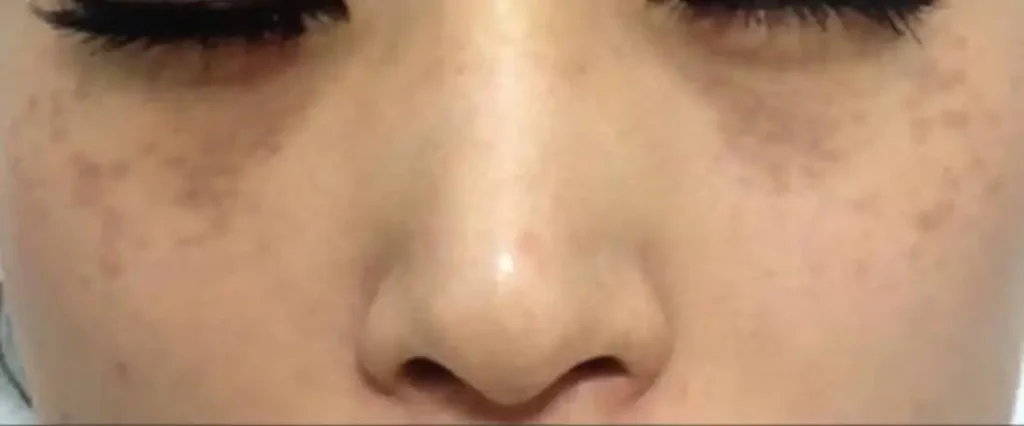
(Tian, 2015)
Hori’s nevus typically appear as dark brown or grayish round spots. They are often found in clusters on both sides of the cheeks and both temples, commonly starting around the ages of 20–30. Genetics play a role, with a higher prevalence in females at a ratio of 21:1 compared to males. They resemble freckles but tend to have a more grayish hue, hence the name “Hori’s nevus”
These spots do not fade away on their own and often darken over time. Treatment typically involves targeted laser therapy to remove both epidermal (top layer) and dermal (deeper layer) pigmentation. Picosecond laser is effective, with a minimum of 5 sessions required due to the deep-seated nature of lentigines. Topical treatments or superficial laser therapy targeting only the epidermal layer are ineffective in eliminating lentigines since the melanin deposits are deep within the dermis or inner layers of the skin. Laser treatment may cause transient hyperpigmentation, which typically fades after using whitening agents.
Red and Dark spots from acne

Post-inflammatory erythema (PIE) and post-inflammatory hyperpigmentation (PIH) are residual marks that occur after the inflammation of acne. PIE appears as red marks resulting from inflammation of the underlying tissue combined with the expansion of blood vessels. On the other hand, if inflammation persists over a prolonged period, it stimulates melanocytes to produce excess melanin, resulting in post-inflammatory hyperpigmentation or dark spots after the acne heals. Therefore, gradual and consistent care of inflamed acne can help reduce the severity of acne marks.
Melanocytes are cells that produce melanin, the natural pigment that determines skin color, hair color, eye color, and post-acne dark spots. These dark spots occur due to excessive melanin production or the release of excessive melanin produced by melanocytes, making the dark spots darker than other areas. Thus, individuals with fair skin tend to have a faster fading of dark spots and red marks compared to those with darker skin, as dark spots may linger longer in the latter.
Basic treatment for dark spots usually involves skincare products containing ingredients such as niacinamide, vitamin C, retinol, etc. However, noticeable improvement may take some time and patience.
Currently, the most effective and fastest method for removing dark spots and post-acne marks is Picosecond Laser, the latest innovation in laser technology. It directly affects and destroys melanin granules within seconds, using energy at 1/1,000th of the nanometer level of the traditional Q-switched laser system. Treatment typically requires about 3–5 sessions, depending on the severity of the individual’s condition.
Treatment options for mild to moderate hyperpigmentation, such as post-inflammatory erythema (PIE) and post-inflammatory hyperpigmentation (PIH), include:
Skin exfoliation:
- Chemical peels: Chemicals are applied to the skin to exfoliate the top layer, revealing new, healthier skin underneath.
- Microdermabrasion: A minimally invasive procedure that uses a diamond-tipped wand to gently exfoliate the skin, promoting cell turnover.
Stimulating skin cell turnover in the dermis:
- Vitamin A acid: Also known as retinoids, these compounds promote skin cell turnover and help fade pigmentation.
- Glycolic acid: A type of alpha hydroxy acid (AHA) that exfoliates the skin and encourages the growth of new, evenly pigmented skin cells.
- Salicylic acid: A beta hydroxy acid (BHA) that penetrates deep into the pores to unclog them and improve skin texture
Inhibiting melanin synthesis:
- Hydroquinone: A popular skin-lightening agent that inhibits melanin production.
- Arbutin, kojic acid, licorice extract, tranexamic acid: Other skin-lightening agents that may be effective but are less commonly used due to lower efficacy and higher cost.
Reducing melanin transfer from melanocytes to keratinocytes:
- Laser treatments: Q-switched laser, fractional laser, and picosecond laser are popular options that can target melanin deposits within the skin.
It’s important to note that prolonged use of hydroquinone can lead to rebound hyperpigmentation, where the skin becomes darker than before. Therefore, treatment goals should focus on reducing existing pigmentation, inhibiting the formation of new pigmentation, and preventing future pigmentation by avoiding UV radiation exposure.
While there is no definitive cure for hyperpigmentation, laser treatments have become increasingly popular due to their ability to target melanin deposits effectively. These lasers should ideally have:
- Short pulse width in the nanosecond or picosecond range.
- Adjustable energy levels.
- Wavelengths in the visible to near-infrared range (approximately 1,100 nm).
Studies on ablative laser resurfacing for treating hyperpigmentation have shown that it can cause discomfort, prolonged downtime, and potential uneven skin tone afterwards. Severe side effects such as scarring may also occur. Therefore, to ensure effective treatment, laser penetration into the dermis is necessary to target the root cause of pigmentation. Skin resurfacing with lasers that induce skin peeling (e.g., CO2 or Erbium YAG laser) may provide better results, although they come with longer downtime and a higher risk of side effects.
In the treatment of pigmentation abnormalities, lasers based on the principles of Selective Photothermolysis, which generate heat at the targeted area, have been explored. However, outcomes using lasers such as 532 nm frequency-doubled Q-switched Nd: YAG, 694 nm Q-Switched ruby, or 755 nm Q-switched alexandrite have been unsatisfactory. Similarly, the use of Intense Pulsed Light (IPL), which has a broad spectrum ranging from 515 to 1,200 nm, has been widely employed. Unlike lasers, IPL does not require specific targeting. Its light waves can penetrate both the superficial and deep layers of the skin, with a pulse duration in the millisecond range, allowing for effective heat dispersion and reduced risk of side effects from excessive heat. However, IPL treatment for pigmentation abnormalities should be combined with topical therapy, such as hydroquinone creams, especially for treating superficial and mixed pigmentation types, to achieve better outcomes compared to deep or mixed pigmentation types.
Q-switched laser technology is considered Minimally Selective Photothermolysis due to its extremely short pulse durations, which are shorter than those of IPL by approximately one million times. Q-switched NdYAG lasers have been in use since around 1990 and include ruby (694 nm), alexandrite (755 nm), and neodymium-doped yttrium aluminum garnet (Nd:YAG; 532 nm or 1064 nm) lasers. These lasers have been used for tattoo removal, pigmented lesions, and even freckles, leading to the expectation that they could effectively treat hyperpigmentation. However, due to their limitations in targeting only the epidermal layer of the skin, the results in treating hyperpigmentation have not met expectations.
Studies on using Q-switched ruby lasers for treating hyperpigmentation have not shown significant improvements, with some patients returning to their original skin tone several months after treatment. Similarly, studies on Q-switched alexandrite laser and combined carbon dioxide (CO2) and Q-switched alexandrite laser therapy have also yielded unsatisfactory results, with reported side effects from the treatment. Subsequently, low fluence or subthermolytic Q-switched lasers have been developed in an attempt to mitigate side effects and improve treatment
Q-switched Nd:YAG laser has gained significant popularity as it can effectively address pigmentary concerns such as freckles, lentigines, melasma, and post-inflammatory hyperpigmentation with deeper penetration into the skin compared to traditional treatments like chemical peels or topical treatments. The principle of Q-switched laser treatment involves breaking down pigment or dark spots without affecting the surrounding skin. The laser energy is absorbed by the pigment, causing it to fragment into smaller particles within the skin cells, which are then naturally eliminated by the body’s lymphatic system.
The advantage of Q-switched lasers lies in their ability to penetrate deeper layers of the skin compared to creams or superficial treatments, targeting the root cause of pigmentation problems. Additionally, the procedure is minimally invasive and has fewer side effects compared to ablative laser resurfacing.
However, it’s essential to note that while Q-switched Nd:YAG laser treatment is generally safe, it may still have some side effects. These can include temporary discomfort during the procedure, redness, swelling, itching, or temporary darkening (hyperpigmentation) or lightening (hypopigmentation) of the treated area. These side effects usually resolve on their own within a few days to weeks.
Overall, Q-switched Nd:YAG laser is considered an effective and safe option for treating various pigmentation concerns, but it’s essential to consult with a qualified dermatologist or laser specialist to determine if it’s the right treatment for your specific needs.
Why doesn’t using lasers to treat melasma fully meet the needs?
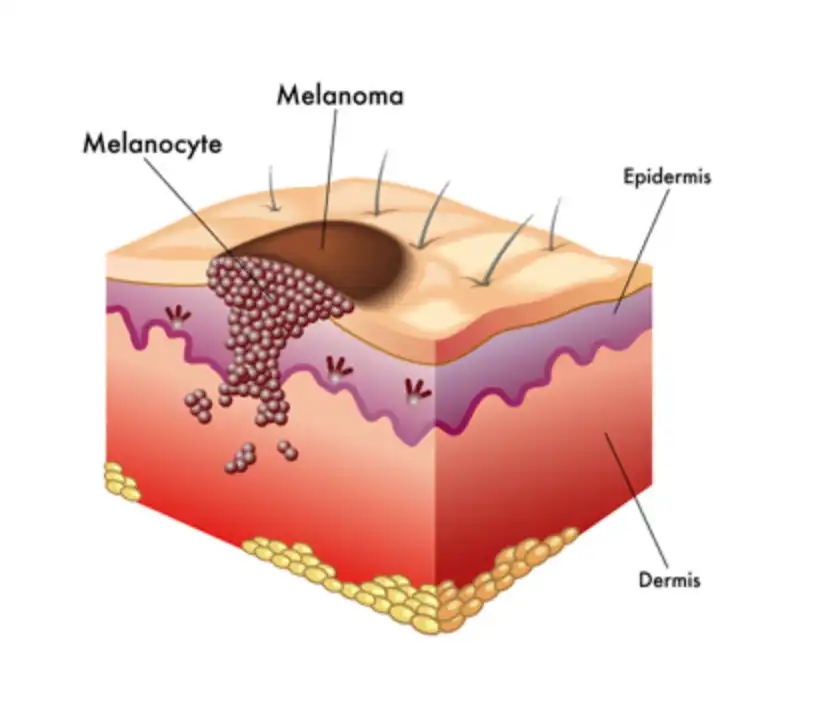
From the structure of the skin, we can see that the outermost layer, called the epidermis, contains keratinocyte cells, which produce keratin, a component found in normal skin cells. Similarly, melanin granules, which are produced by melanocytes, are normally found in the deeper layers of the epidermis. Popular technologies for treating freckles, such as Q-switched lasers, can directly cause melanin granules to disperse into melanosomes, which are sacs containing melanin granules located in the epidermal layer, without causing redness, bruising, or requiring post-treatment downtime. Therefore, Q-switched lasers are highly favored.
However, since the cause of freckles, as well as abnormalities in melanin, has not been addressed, melanocytes, which are the root cause of melanin production and are located in the deep epidermal and dermal layers, are not targeted and continue to produce melanin normally. This leads to the continuous reappearance of freckles. Thus, traditional laser systems only provide results on the superficial skin layer and cannot address freckles deep within the skin, particularly in the dermal layer.
Picosecond lasers offer a solution for treating freckles, spots, and pigmented lesions by targeting melanin deep within the skin, specifically in the dermal layer. This advanced technology is more effective in eliminating pigmented lesions and requires less time for treatment.
A picosecond laser is a cutting-edge technology that operates with pulse widths in the picosecond range (trillionths of a second), delivering high-frequency light energy at speeds of up to one trillionth of a second (10–12 s). This technology surpasses Q-switched lasers, which operate with pulse widths in the nanosecond range (billionths of a second), by generating ultra-short picosecond pulses with extremely narrow pulse widths. These pulses are aimed directly at melanin within the skin, particularly within melanosomes, sacs containing melanin granules located in the epidermal layer. This targeting leads to the creation of a powerful mechanical (acoustic) wave that impacts chromophores, such as tattoo ink or melanin granules, causing them to disperse more effectively than from the heat generated by traditional lasers. This mechanism, known as the photoacoustic effect, results in highly efficient treatment, with melanin granules being fragmented more finely than with nanosecond laser technology, and eliminates the risk of heat accumulation and potential side effects on surrounding tissues.
Additionally, micro lens arrays can be used to focus laser beams into multiple small points, each with significantly higher energy, creating a fractional beam profile. This intensified impact triggers the formation of micro-cavities in the epidermal and dermal layers of the skin, stimulating the production and rearrangement of collagen, reducing wide pores, acne scars, and improving skin elasticity.
Furthermore, when an excess of melanin granules leads to the formation of pigmented lesions, they can be treated with lasers specifically designed for pigment removal. These lasers can target pigmented lesions based on their depth within the skin, whether in the epidermis, dermis, or both layers. By precisely targeting the depth of the pigmented lesion, the appropriate laser type and wavelength can be selected for optimal treatment outcomes.
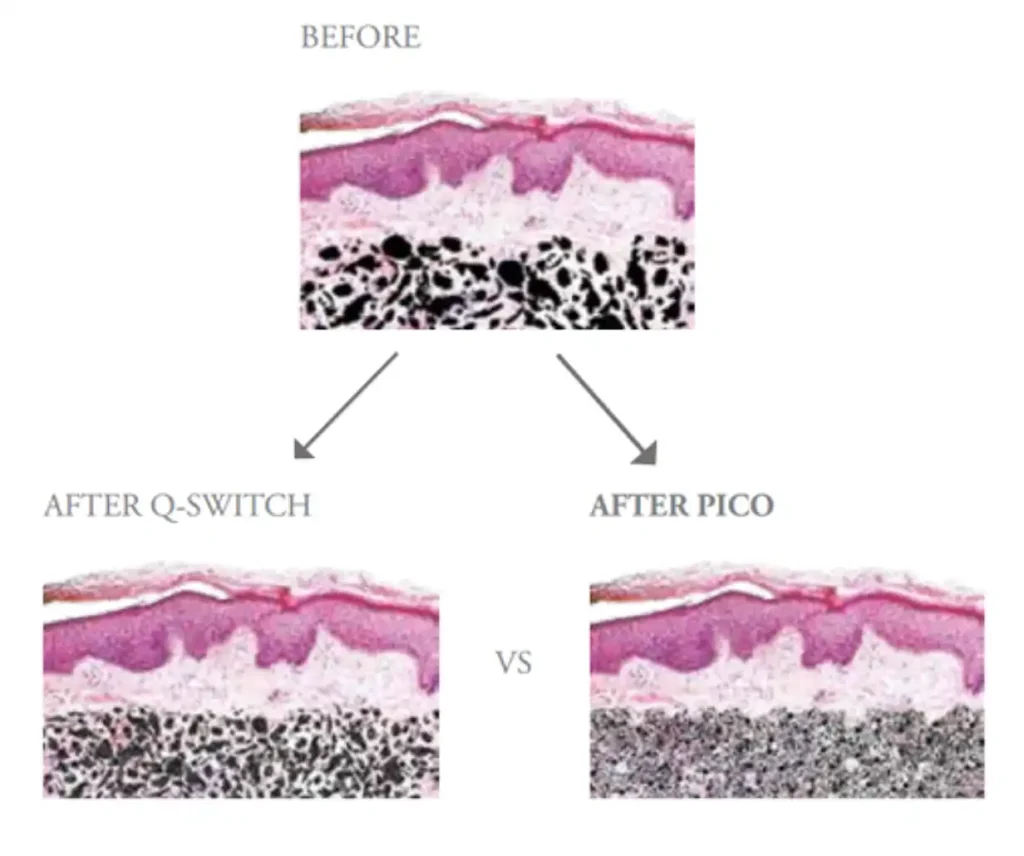
When comparing the efficacy of tattoo removal, Q-switched nanosecond lasers have shown good results in removing single-colored tattoos, particularly black ink tattoos. However, their effectiveness in removing multicolored tattoos is less clear. On the other hand, picosecond lasers, with their extremely short pulse widths, have demonstrated the ability to remove multicolored tattoos effectively. This technology represents a significant advancement in tattoo removal, reducing scarring, and treating pigmentary abnormalities.
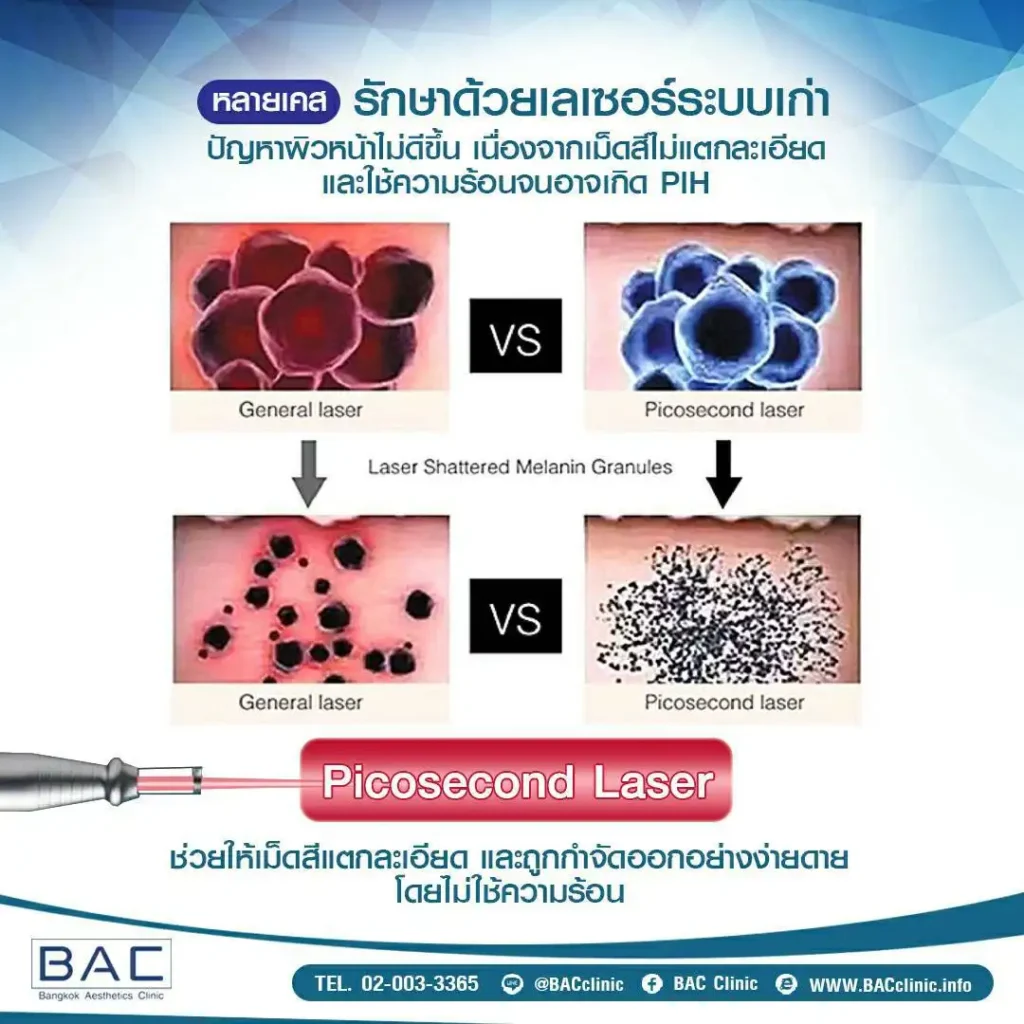
Interested in treating melasma with the latest technology while rejuvenating skin cells comprehensively?
Our specialized technique targets the root cause of melasma, addresses skin inflammation, reduces the density of accumulated melasma, and revitalizes skin condition. Witness fast results without thinning the skin. Trusted by thousands of satisfied customers with over ten thousand cases of experience.
Why might treating melasma with a Picosecond laser at a wavelength of 755 nm not be the ultimate solution?
Even though Picosecond lasers have been utilized in numerous clinics and have supporting theories, there are still several points worth considering. For example,
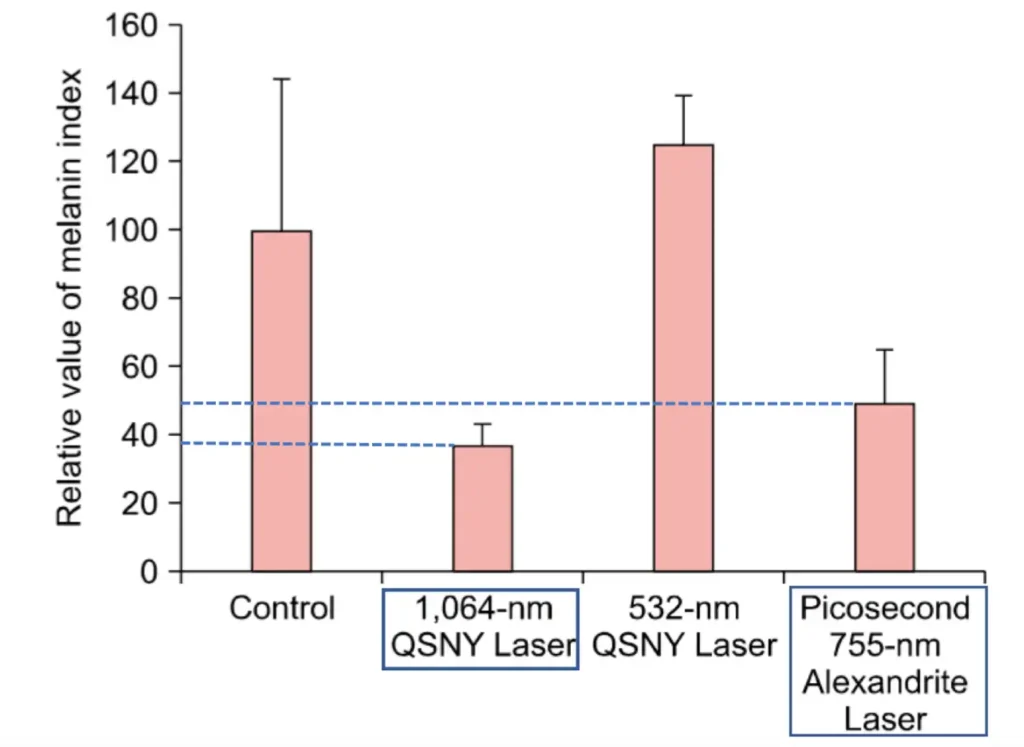
Based on the clinical trial results (Lee et al., 2017), which measured the amount of melanin after 7 days of treatment with different lasers, including 1,064 nm Q-switched NdYAG laser, 532 nm Q-switched NdYAG laser, Picosecond 755 nm Alexandrite laser, and a control group, it was found that the 1,064 nm Q-switched NdYAG laser was more effective at reducing melanin levels compared to the Picosecond 755 nm Alexandrite laser, as measured by the Melanin index.
Therefore, BAC Clinic chose to use the Picosecond Laser with a wavelength of 1,064 nm, which has empirical evidence confirming its suitability for Asian skin conditions and provides better treatment outcomes for pigmentary disorders compared to the 755 nm wavelength. Additionally, the use of Picosecond Laser offers several advantages over traditional laser systems, such as avoiding heat accumulation under the skin, higher efficacy in removing excess pigmentation, and stimulating collagen regeneration, thereby improving wide pores and reducing wrinkles. It is the latest laser system that comprehensively addresses skin issues in Asian individuals.
However, melasma and pigmentary disorders have multifactorial causes. Factors contributing to melasma can stimulate its recurrence as long as the root cause remains unresolved. Therefore, even though treatment options have advanced, achieving a 100% resolution remains challenging, explaining why melasma treatment continues to pose a global challenge with a high likelihood of recurrence.
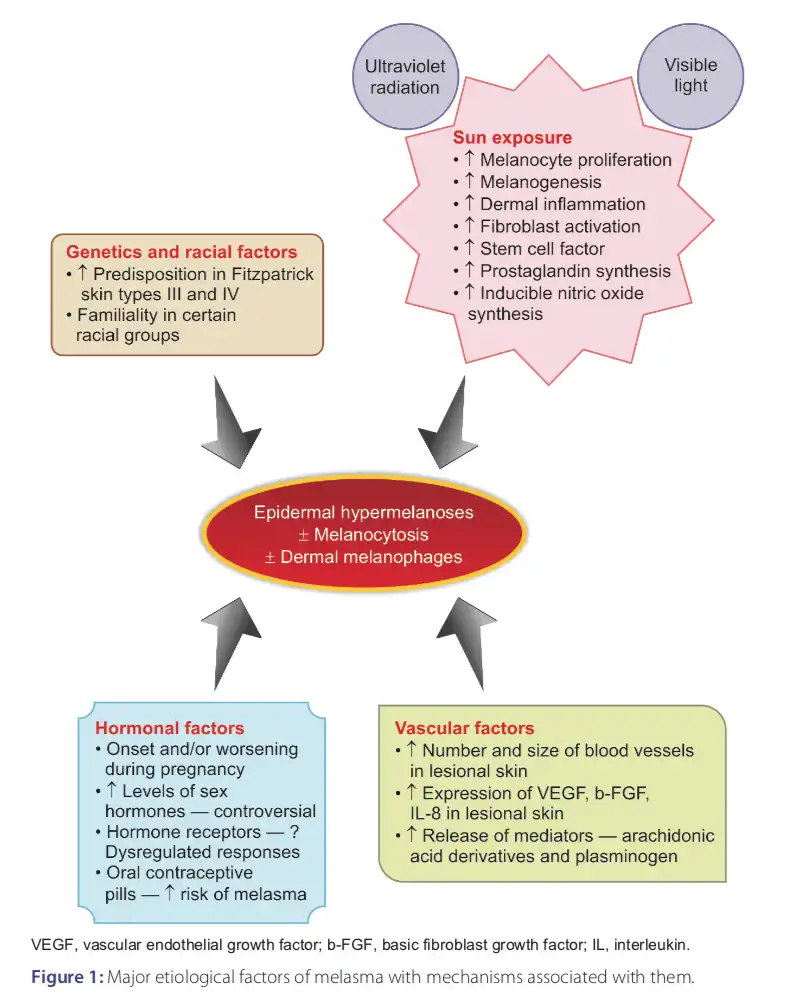
(Sonthalia, S., 2014)
The use of lasers and light-based treatments directly affects melanin granules and molecules beneath the skin’s surface. However, they cannot prevent the recurrence of melanin granules from melanocytes beneath the skin, which continue to be stimulated by various factors. Therefore, it’s not surprising that using lasers and light alone may not completely treat pigmentation issues and is not considered the first-line treatment. Understanding the process of pigmentation and the factors that trigger it is essential to tailor treatments to each individual.
What is the best approach to treating pigmentation?
The best approach to treating pigmentation varies for each individual depending on treatment goals because pigmentation arises from multiple factors. Treating and preventing pigmentation issues at the root cause is the most effective method. Therefore, no single treatment method is sufficient. Combination therapies, which involve using multiple treatment methods together, are often necessary. It may not always be necessary to use expensive laser equipment because pigmentation issues vary in severity. Using light-based treatments like IPL therapy, topical creams, or chemical peels may suffice for some individuals.
Why choose pigmentation treatment at BAC Clinic?
The program is specifically designed to directly treat pigmentation using gentle yet highly effective laser techniques. The program also includes cell repair procedures at the root cause, eliminating pigment granules in individuals with pigmentation issues, thus helping to fade pigmentation without thinning the skin. It helps repair skin cells for long-term skin resilience, reducing the chances of pigmentation recurrence. Additionally, it stimulates collagen production beneath the skin’s surface, improving skin texture. BAC Clinic incorporates mesotherapy to repair skin cells gently and accelerate pigment removal, with its specialized techniques.
Since pigmented skin requires special care, BAC Clinic uses Picosecond Laser treatment with appropriate energy levels.
Non-Bloody Techniques: Treatment methods with controllable energy are used to gently and effectively treat the skin while minimizing the risk of blood vessel damage, particularly crucial for individuals with pigmentation issues or skin color concerns, where high-energy treatments should be avoided.
At BAC Clinic, we utilize cellular repair techniques by employing PRP-Regen Lab for clinical use in treating melasma. The starting price for PRP is 7,900 baht, while PRP-Regen Lab starts at 12,900 baht.
The clinical use of PRP-Regen Lab for treating melasma is supported by a study conducted by Çayırlı and colleagues in 2014.
In this study, the PRP-Regen Lab technique was utilized to treat melasma in patients aged 27, who had been experiencing melasma for approximately 5 years. Blood was extracted from the patients, approximately 8 milliliters, using test glass and centrifuged at a speed of 3,500 rpm for 8 minutes. The PRP-Regen Lab portion, located in the buffy coat area, was then separated. Using a 32 G needle, the PRP-Regen Lab was injected into the subdermal layer using a mesotherapy technique, targeting the papillary dermis at a depth of approximately 1.5 to 2.0 millimeters. Approximately 1.5 milliliters of PRP-Regen Lab was injected in total, divided into 3 sessions spaced 15 days apart. At the end of the study, epidermal melasma was reduced by approximately 80% without additional treatment, except for sunscreen application, as shown in Figure 2 (after).
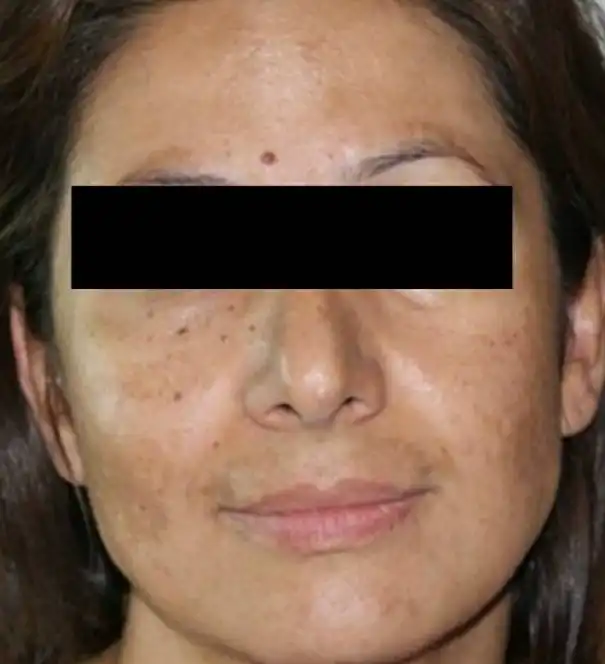

Figure 2 depicts the results before and after treatment with PRP-Regen Lab (Çayırlı et al., 2014)
The important components of blood flakes in α-granules contain over 30 biologically significant substances, including platelet-derived growth factor (PDGF), transforming growth factor (TGF)-β1, 2, epidermal growth factor, and mitogenic growth factors such as platelet-derived angiogenesis factor and fibrinogen. According to existing data, TGF-β1 is a growth factor associated with melasma development. Kim et al. studied the role of TGF-β1 in melasma development and found that TGF-β1 inhibits melanin production in a concentration-dependent manner, statistically significantly delaying extracellular signal-regulated kinase activation. In addition to the role of TGF-β1, the improvement in treatment outcomes may be related to skin thickening and strengthening, as PDGF plays a significant role in new blood vessel formation, collagen, and hyaluronic acid, components of the extracellular matrix. Hyaluronic acid has been shown to increase skin transparency and volume, contributing to skin rejuvenation. Therefore, the use of PRP-Regen Lab is an interesting option for individuals with melasma, as it not only reduces melanin production at the cellular level but also strengthens and rejuvenates the skin at the cellular level, reducing the likelihood of inflammation and thus reducing the recurrence of melasma.




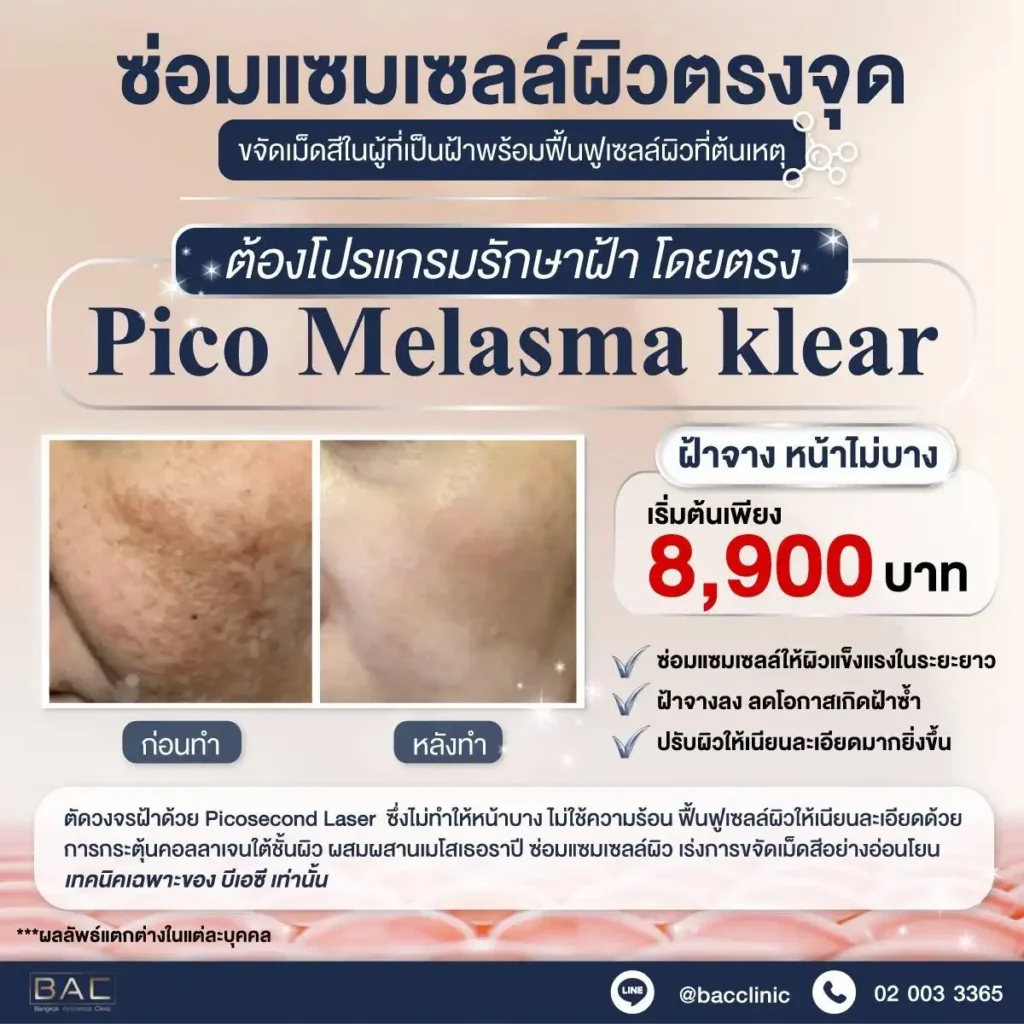
Common abnormalities of pigmentation include:
- Freckles
- Sun spots or Solar lentigines
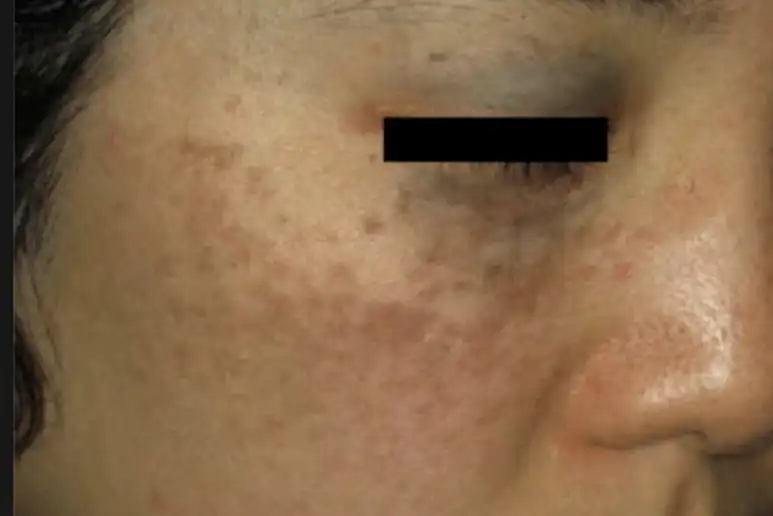
3. Hori’s Nevus
4. Melasma
5. Post-inflammatory hyperpigmentation (PIH)
“Pigmentation abnormalities encompass more than just freckles; they often involve a variety of issues.”

Dark spots, brown patches found on the skin have various names depending on the issue encountered, such as age spots, sunspots, uneven skin tone, freckles, and melasma. In one patient, multiple types of dark spots can be present, and although these problems may not pose a danger, they are generally unwelcome. These pigmentation issues often occur with age, especially after the age of 50, primarily due to sun exposure. Therefore, the best prevention is sunscreen application combined with the treatment of existing dark spots. Since dark spots have different names depending on the underlying factors, the choice of laser treatment varies. Thus, it is essential for physicians to diagnose and plan treatment to achieve the desired goals and reduce patient anxiety about their skin issues.
Factors that stimulate the formation of freckles and dark spots include hormonal changes, which can occur during pregnancy or when taking birth control pills. Freckle problems are particularly common during pregnancy, and abnormal pigmentation tends to fade after childbirth. For those experiencing freckles due to birth control pills, it’s advisable to consider alternative contraceptive methods to address this issue.
Regular application of sunscreen is essential. It’s recommended to choose a broad-spectrum sunscreen that protects against both UVA and UVB rays, with a minimum SPF of 15. Sunscreen should be applied at least 20 minutes before sun exposure and reapplied throughout the day. Nowadays, there are various sunscreen formats available, and using spray sunscreen can be convenient for reapplication during the day.
Medical treatment to reduce pigmentation abnormalities should be administered by a dermatologist. They will diagnose and prescribe appropriate treatments to suppress factors that stimulate freckle formation. Hydroquinone remains the gold standard for treating pigmentation abnormalities like freckles, sunspots, and dark spots, effectively reducing their intensity. However, caution must be exercised regarding potential side effects from long-term use. Combination therapy, such as combining hydroquinone with retinoids, is also an option. Additionally, other agents with lower efficacy levels, such as arbutin and vitamin C, can be used based on individual suitability.
Transamin, a medication discovered incidentally, is commonly used to treat freckles. It contains lysine, which inhibits melanin production and is involved in the suppression of the plasminogen activator process. However, its mechanism of action is not yet fully understood.
Chemical peels are another method of managing freckles, similar to laser treatment. Chemicals used for peeling, such as glycolic acid, lactic acid, and Jessner’s peel, affect the upper layers of the skin or the epidermis and dermis. However, it’s important to note that most pigmentation issues originate from deeper layers of the dermis or true skin. Therefore, using chemical peels that penetrate deeper layers may lead to side effects such as skin irritation, post-inflammatory hyperpigmentation (PIH), or dark spots, especially in Asian skin, which is more prone to such reactions.
When should freckles be treated with lasers?
Freckles or pigmentation abnormalities that resist treatment with freckle-reducing creams or oral medications for 6–8 weeks. Pigmentation abnormalities co-occurring with freckles, such as sunspots, melasma, or Hori’s nevus. When patients wish to rapidly eliminate freckles, such as before important events, and desire quick results, laser treatment should be considered as it provides faster results.
Testimonials
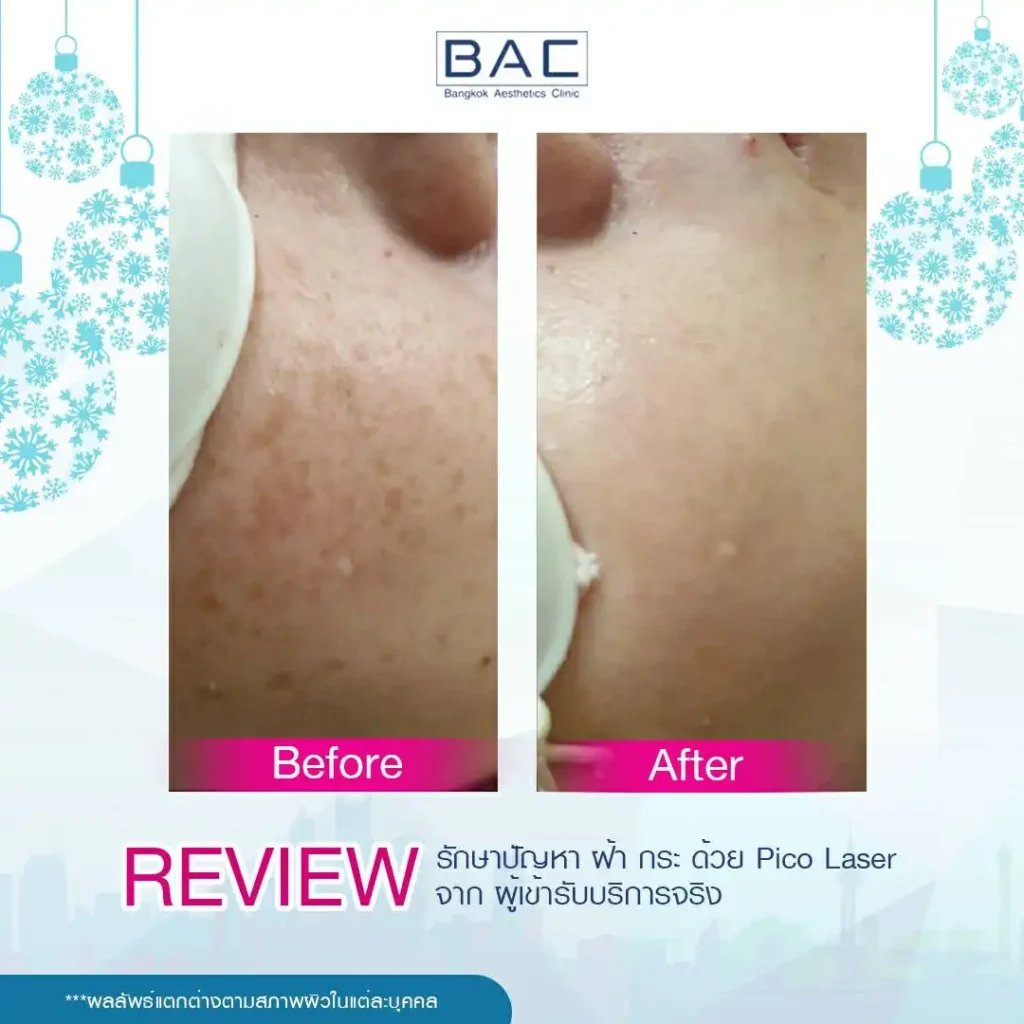
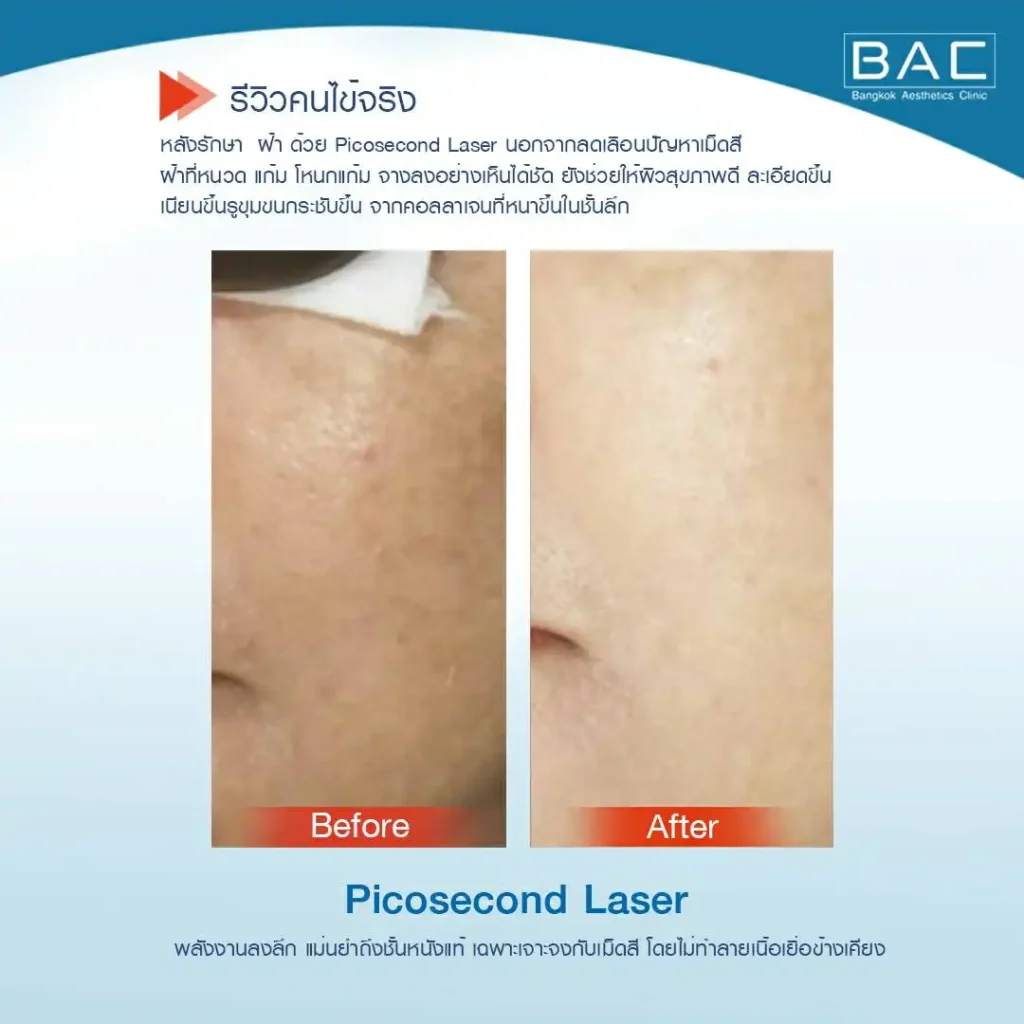
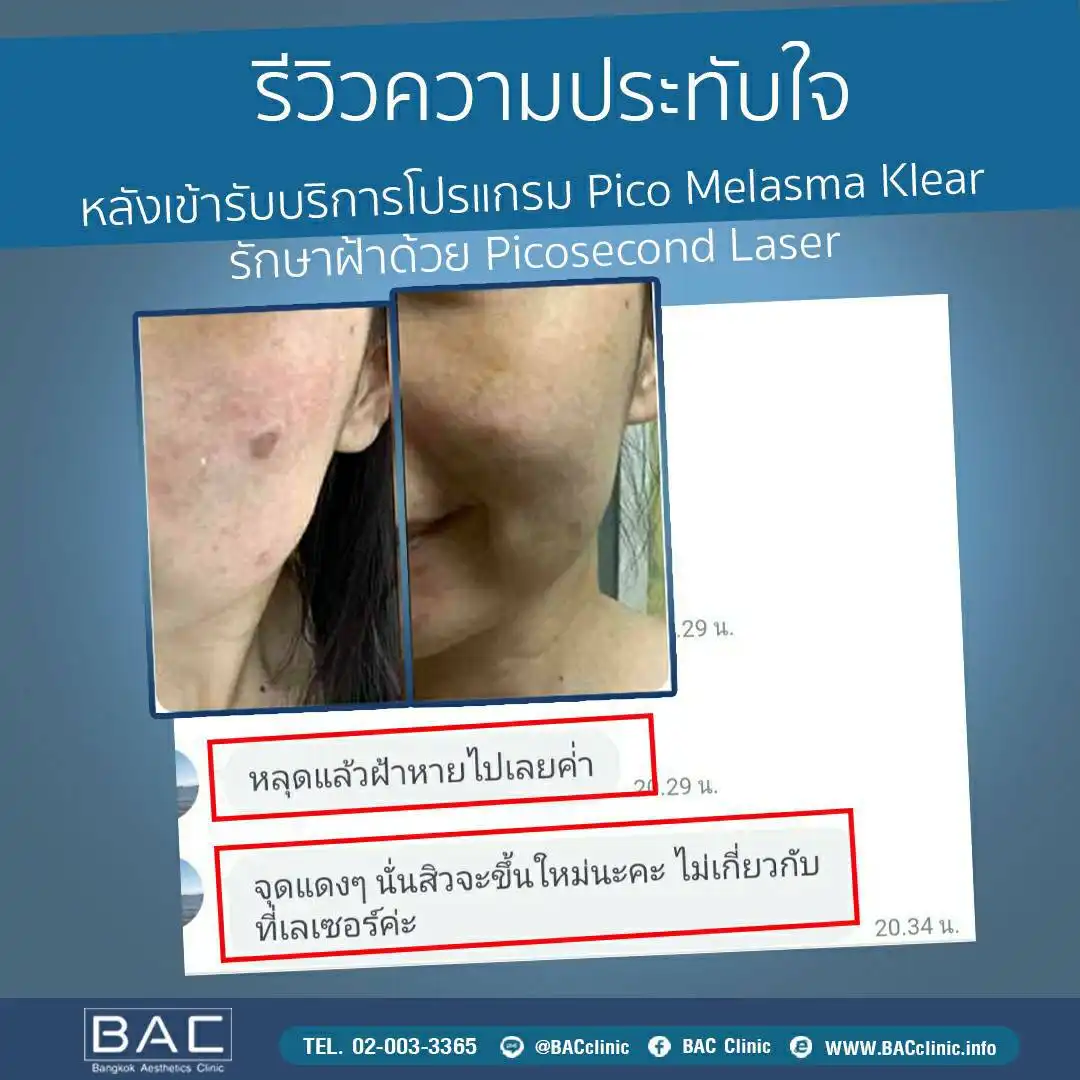


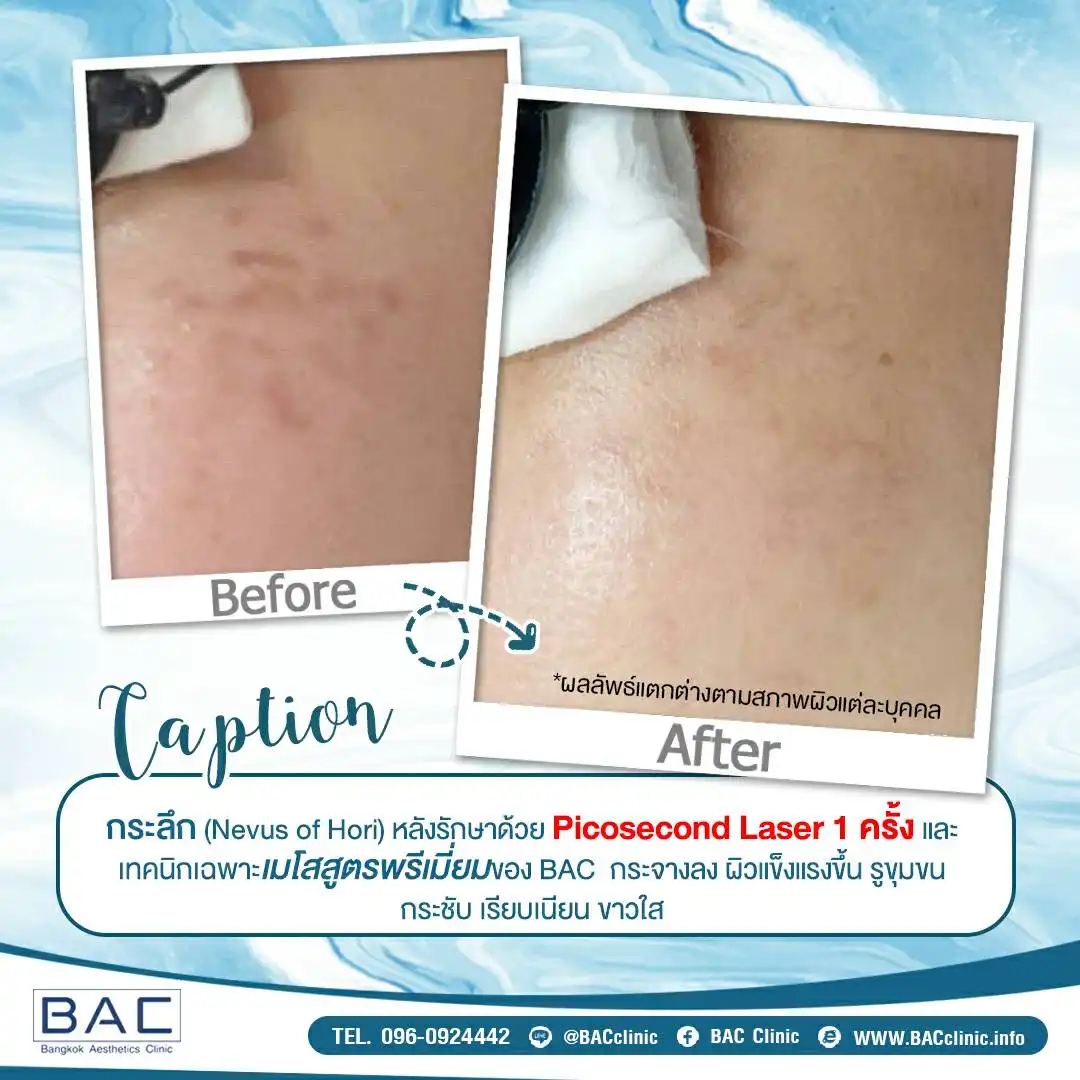
Treatment with lasers can be used alone or in combination with other treatments, and it’s not always necessary to use the same type of laser. This is because the factors contributing to the development of melasma vary from person to person. Additionally, the mechanism behind melasma formation isn’t entirely clear, including the level of abnormalities and skin layers affected, as well as the response to treatment. Other types of abnormal pigmentation may also differ, so treatment plans must be tailored by experienced medical professionals in collaboration with patients to prevent the recurrence of factors contributing to melasma and achieve rapid resolution, with reduced chances of recurrence.
Key Points about Laser Treatment for Melasma (LASER MELASMA TREATMENT FAQS):
In summary, laser treatment for melasma is a valuable option but should be part of a comprehensive treatment plan tailored to individual needs and under the supervision of experienced medical professionals.
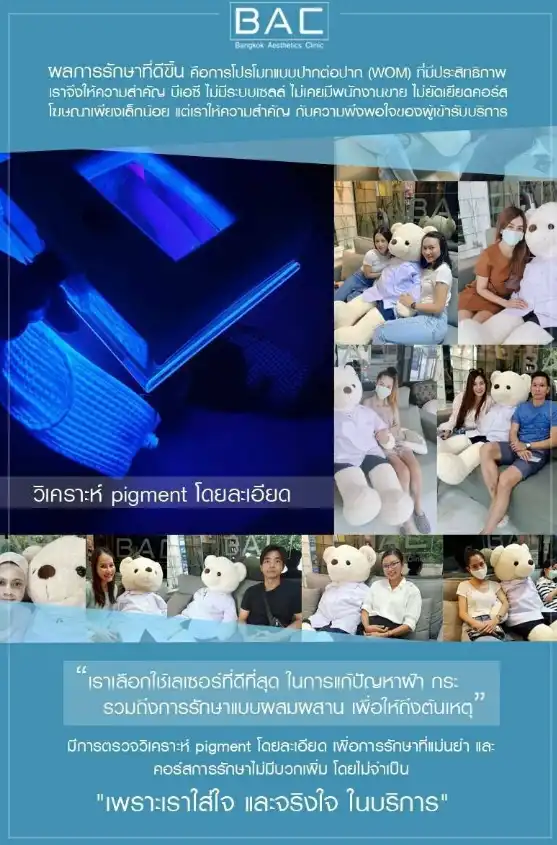
References
Ephelides (freckles) — Dermatology Advisor. (n.d.). Retrieved January 11, 2022, from https://www.dermatologyadvisor.com/home/decision-support-in-medicine/dermatology/ephelides-freckles/
Lee, Y. J., Shin, H. J., Noh, T.-K., Choi, K.-H., & Chang, S.-E. (2017). Treatment of melasma and post-inflammatory hyperpigmentation by a picosecond 755-nm alexandrite laser in Asian patients. Annals of Dermatology, 29(6), 779–781.
Solar lentigines — dermoscopedia. (n.d.). Retrieved January 11, 2022, from https://dermoscopedia.org/Solar_lentigines
Tian, B. W. C. A. (2015). Novel treatment of Hori’s nevus: A combination of fractional nonablative 2,940-nm Er: YAG and low-fluence 1,064-nm Q-switched Nd: YAG laser. Journal of Cutaneous and Aesthetic Surgery, 8(4), 227.
Services:
- VAGINAL REJUVENATION
- BODY SCULPTING & FIRMING
- LIFTHERAPY
- MELASMA TREATMENT
- PICOSECOND LASER
- SCAR & REJUVENATION THERAPY
- ACNE TREATMENT
- OSTEOARTHRITIS
- ACTIVE CELL THERAPY
- LASER HAIR REMOVAL
- INFINITY SCAR LASER
- ACTIVE FACE LIFTING (NON-ABLATIVE)
- SALMON DNA
- CHANEL INJECTION
- CELLULAR MATRIX
- ACNE SCAR SUBCISION
- NAD+ IV THERAPY
- THE COMPLETE GUIDE FOR ACNE SCAR REVISION
- Lipolysis Injection
Contact Information and Location
BAC Clinic has been established with the aim of integrating top-tier treatment options with patient-centric healthcare that delivers value for your investment of time and money. Our proficient team is prepared to elevate the standards of medical tourism.
Clinic License Number : 10101010961
Opening Hours
Tuesday — Friday: 11:00 AM — 8:00 PM
Saturday-Sunday: 11:00 AM — 7:00 PM
Monday: Closed
Find us conveniently located in the vibrant district of Khlong Toei, right in the heart of Bangkok’s Sukhumvit 16 area. We are easily accessible by public transportation, with ample parking available for those who prefer to drive.
To determine whether you are a suitable candidate, Call us now (+66)2 0033365 or
